fizkes // Shutterstock
States with the highest rates of depression
Depression is a leading cause of disability worldwide, according to the National Alliance on Mental Illness, the World Health Organization, and the Pan American Health Organization. Those who suffer from it are at much greater risk for things like metabolic and cardiovascular disease, and the global economy suffers $1 trillion in lost productivity every year to anxiety and depression disorders alone. Substance abuse is more prevalent among people with depression. Young people, who are more than twice as likely to drop out of school when they suffer from depression, are especially vulnerable.
That was all bad enough before the COVID-19 pandemic created economic and social conditions that were ripe for a quieter but equally crushing medical crisis to emerge—in mental health. That crisis has arrived in the form of a dramatic nationwide spike in cases of depression and anxiety since the arrival of the virus—and it’s not hard to understand why. Many who were struggling before the pandemic, and even many who weren’t, were pushed to depression by months of stress, isolation, loss of control, change, instability, and uncertainty—all of which played out against a backdrop of frightening social unrest.
Rates of depression, however, vary considerably from one state to the next. Here, Stacker examines the prevalence of depression in every state in America and then breaks down those findings by key demographics like sex, race, and income.
To determine the states with the highest rates of depression, Stacker used data from the Centers for Disease Control and Prevention’s Behavioral Risk Factor Surveillance System. All 50 states and Washington D.C. are ranked based on the share of the sampled population that reported a depression diagnosis in 2020. The national median for diagnosed depression rates is 19.5%.
It’s important to note that the findings are limited to, in essence, the first nine months of the pandemic, and therefore exclude the time of the pandemic thereafter. Consequently, the data may not represent an uptick in cases—particularly in major depressive episodes—that many states may have realized post-2020.
You may also like: 25 virology terms to help you understand outbreaks, from the common cold to COVID-19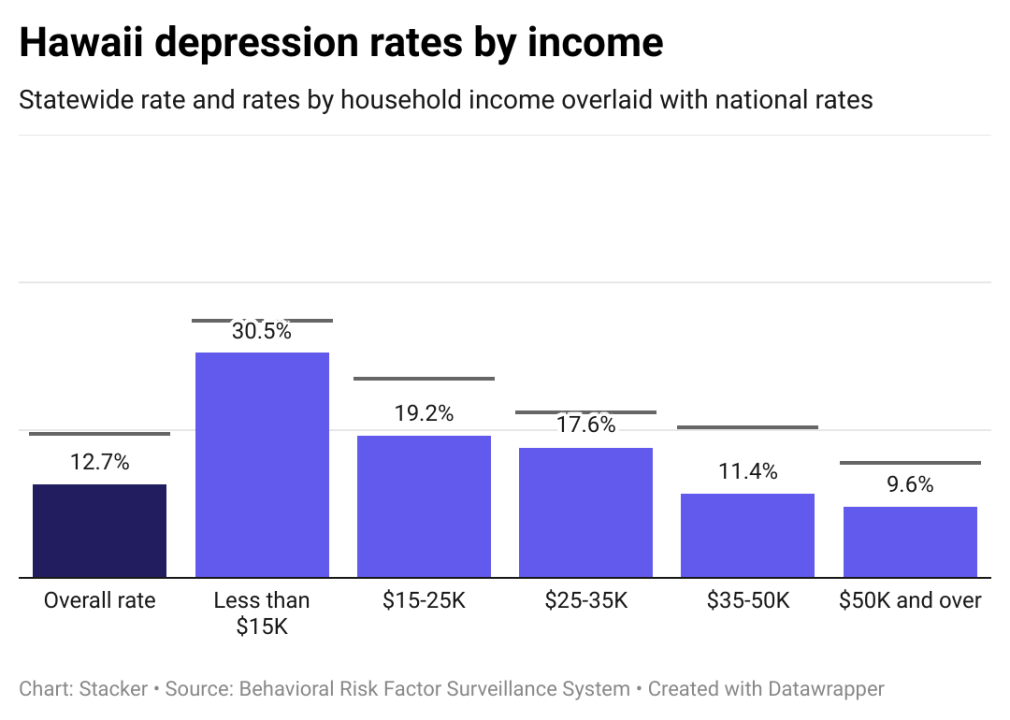
Stacker
#51. Hawaii
– Population diagnosed with depression: 12.7%
– Depression rate breakdown by sex:
— 9.6% rate for male population
— 15.8% rate for female population
– Depression rate breakdown by race/ethnicity:
— 16.5% rate for white population
— 17.8% rate for Hispanic or Latino population
— 8.3% rate for Asian population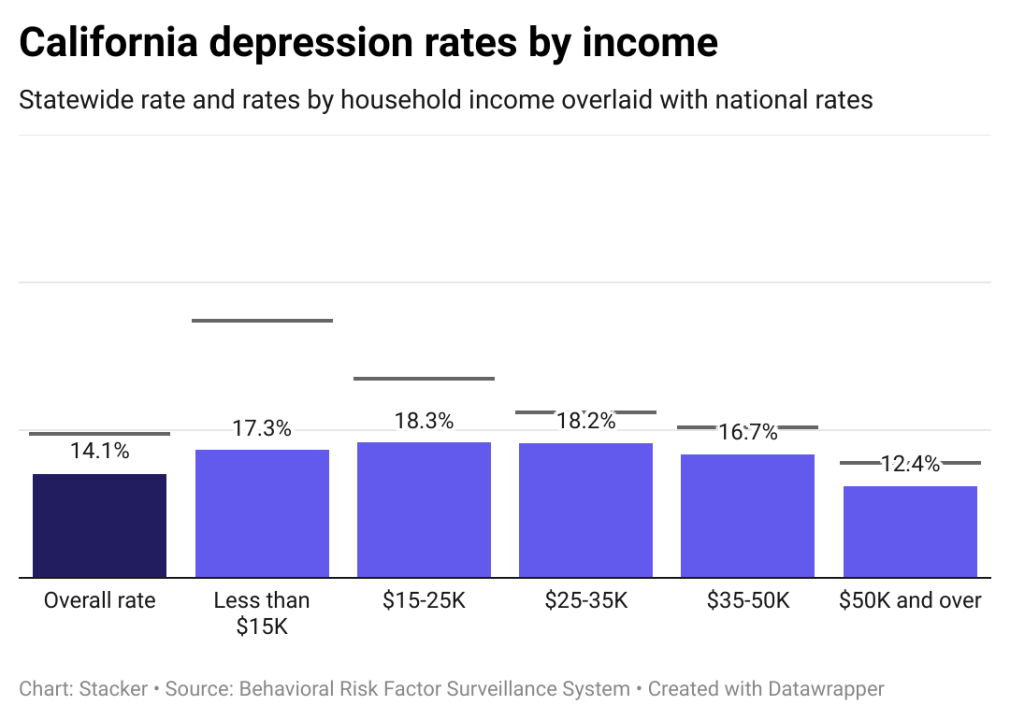
Stacker
#50. California
– Population diagnosed with depression: 14.1%
– Breakdown by sex:
— 9.4% rate for male population
— 18.6% rate for female population
– Breakdown by race/ethnicity:
— 18.4% rate for white population
— 19.7% rate for Black population
— 12.0% rate for Hispanic or Latino population
— 5.2% rate for Asian population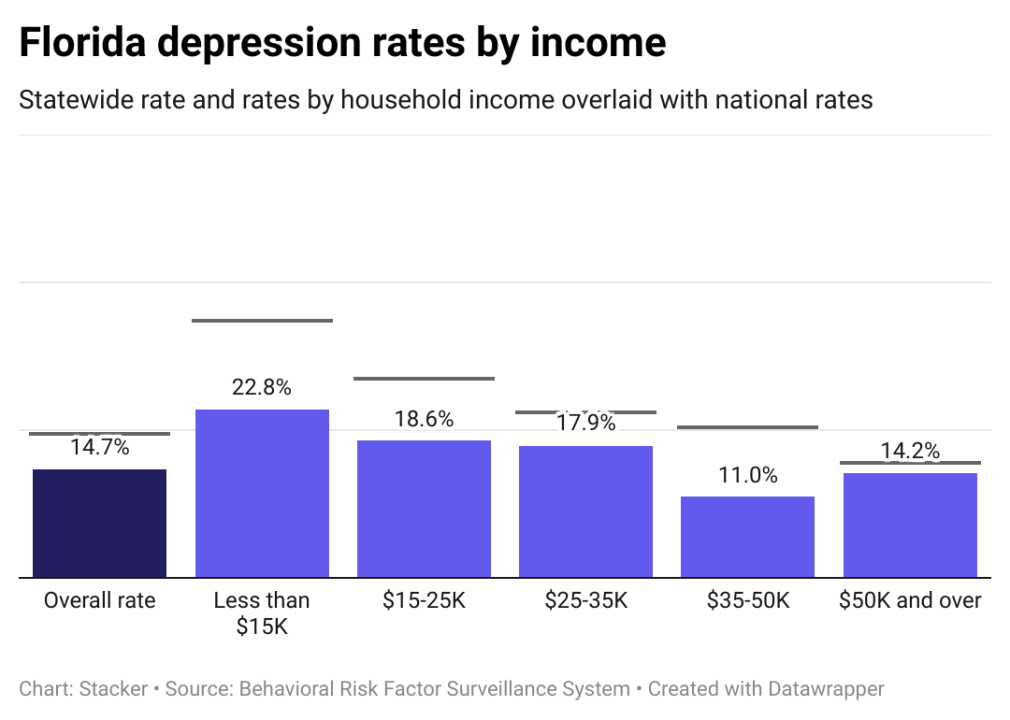
Stacker
#48. Florida
– Population diagnosed with depression: 14.7%
– Breakdown by sex:
— 9.8% rate for male population
— 19.2% rate for female population
– Breakdown by race/ethnicity:
— 17.2% rate for white population
— 11.6% rate for Black population
— 11.2% rate for Hispanic or Latino population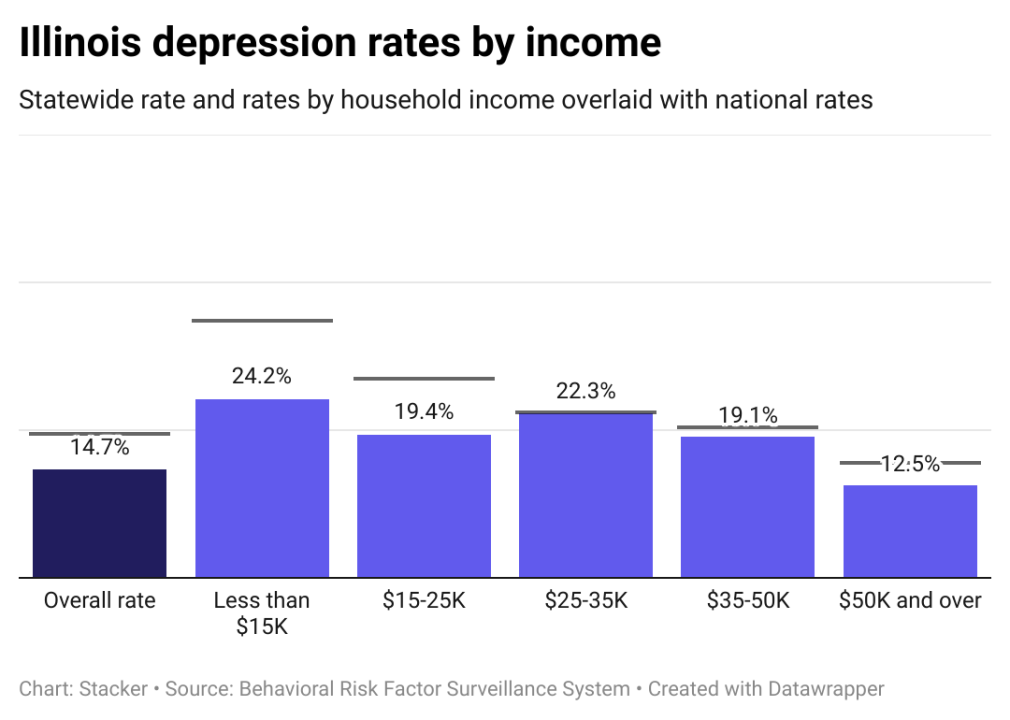
Stacker
#48. Illinois
– Population diagnosed with depression: 14.7%
– Breakdown by sex:
— 11.2% rate for male population
— 18.0% rate for female population
– Breakdown by race/ethnicity:
— 16.1% rate for white population
— 10.2% rate for Black population
— 15.6% rate for Hispanic or Latino population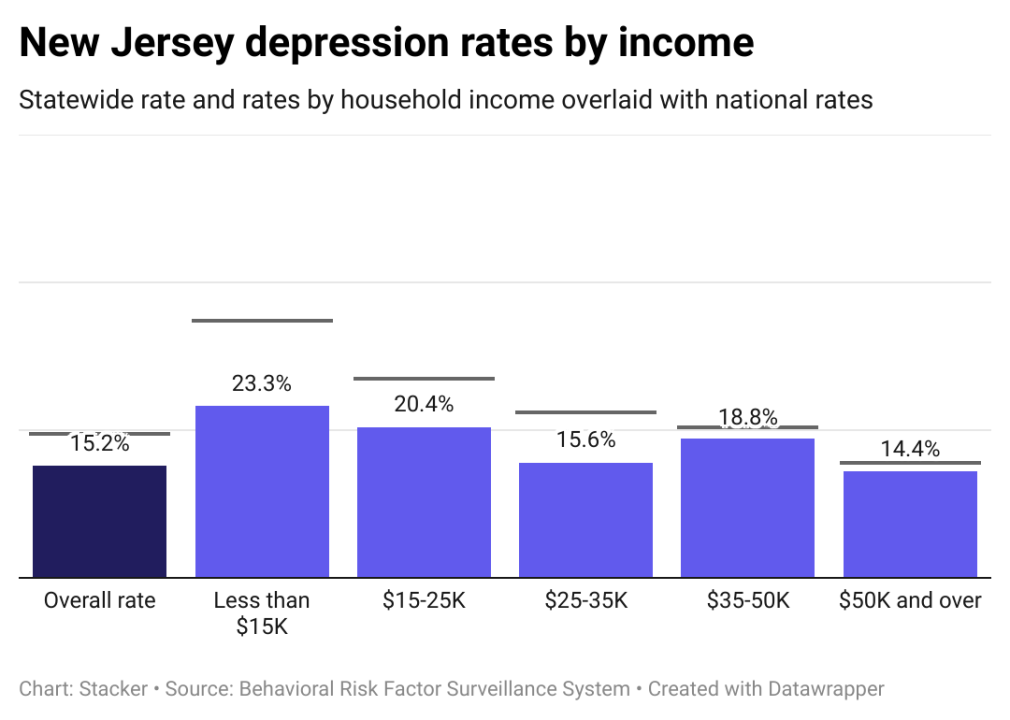
Stacker
#47. New Jersey
– Population diagnosed with depression: 15.2%
– Breakdown by sex:
— 12.2% rate for male population
— 18.0% rate for female population
– Breakdown by race/ethnicity:
— 16.4% rate for white population
— 14.8% rate for Black population
— 14.6% rate for Hispanic or Latino population
— 10.0% rate for Asian population
You may also like: Medical information to have ready in case of emergency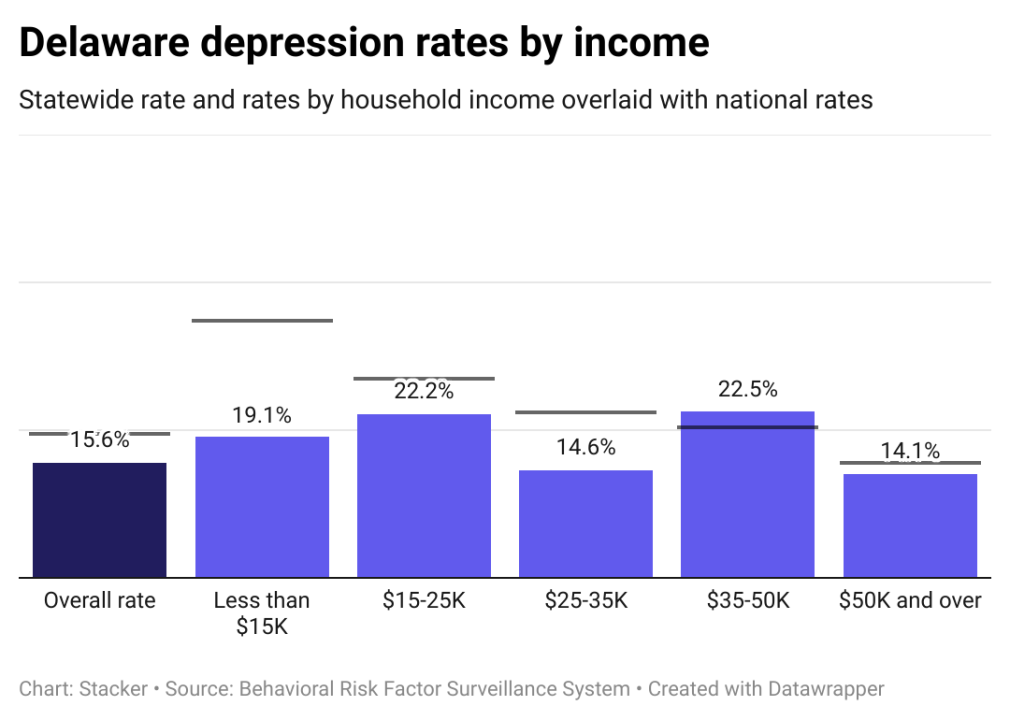
Stacker
#46. Delaware
– Population diagnosed with depression: 15.6%
– Breakdown by sex:
— 10.9% rate for male population
— 19.9% rate for female population
– Breakdown by race/ethnicity:
— 17.7% rate for white population
— 11.6% rate for Black population
— 9.4% rate for Hispanic or Latino population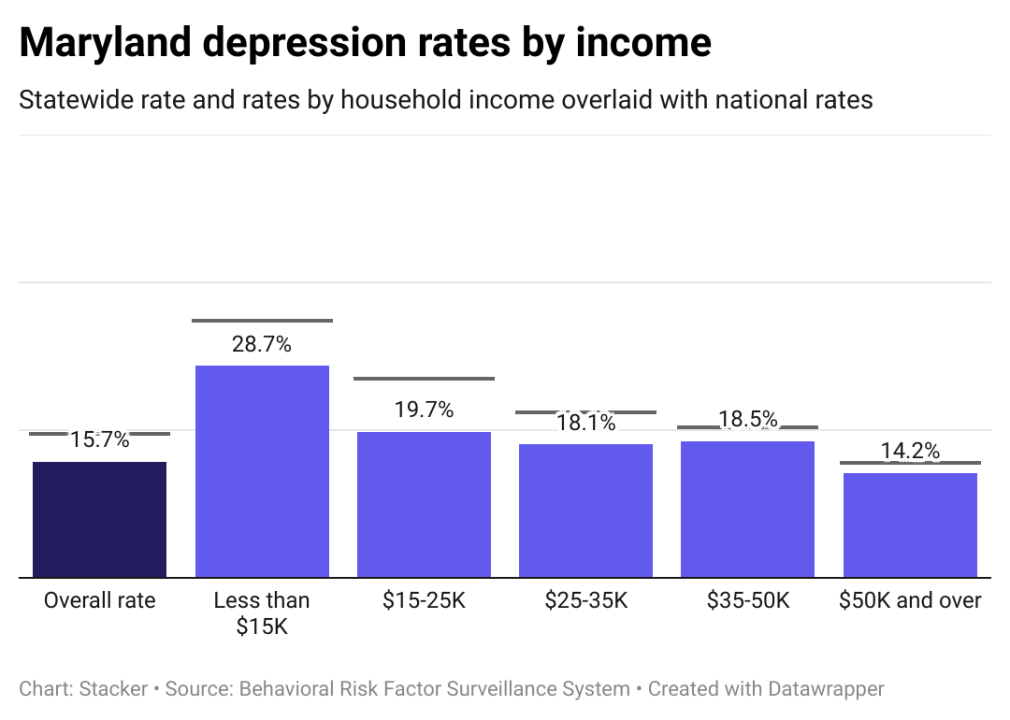
Stacker
#45. Maryland
– Population diagnosed with depression: 15.7%
– Breakdown by sex:
— 12.1% rate for male population
— 19.0% rate for female population
– Breakdown by race/ethnicity:
— 19.0% rate for white population
— 12.6% rate for Black population
— 8.4% rate for Hispanic or Latino population
— 12.0% rate for Asian population
— 29.6% rate for Native American or Alaska Native population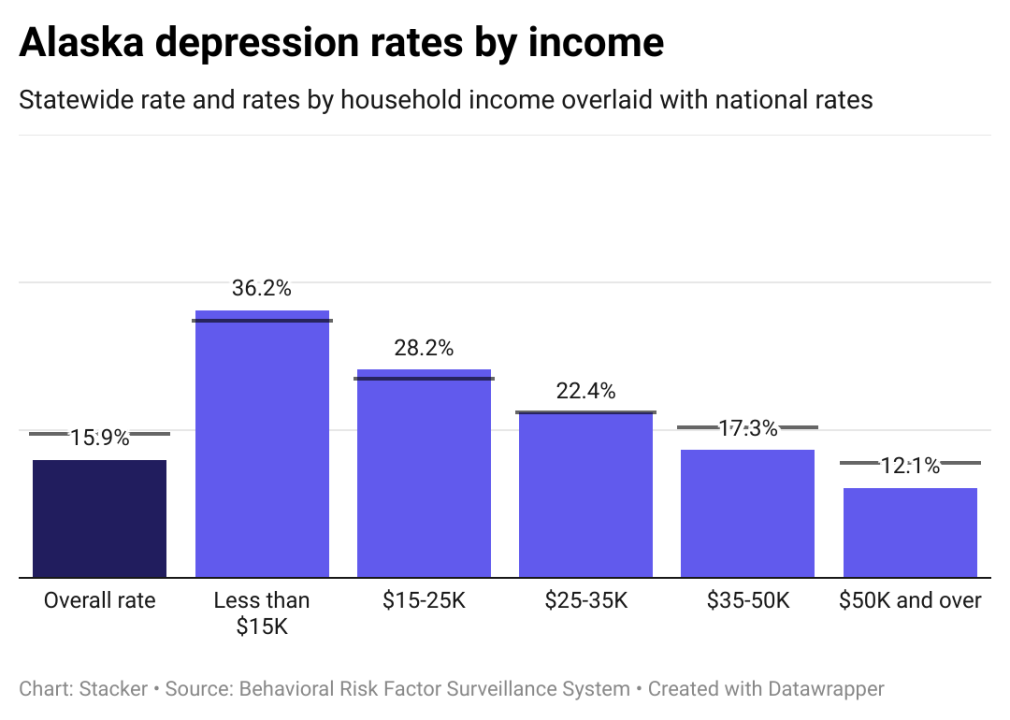
Stacker
#44. Alaska
– Population diagnosed with depression: 15.9%
– Breakdown by sex:
— 9.4% rate for male population
— 23.0% rate for female population
– Breakdown by race/ethnicity:
— 16.6% rate for white population
— 23.7% rate for Hispanic or Latino population
— 12.7% rate for Native American or Alaska Native population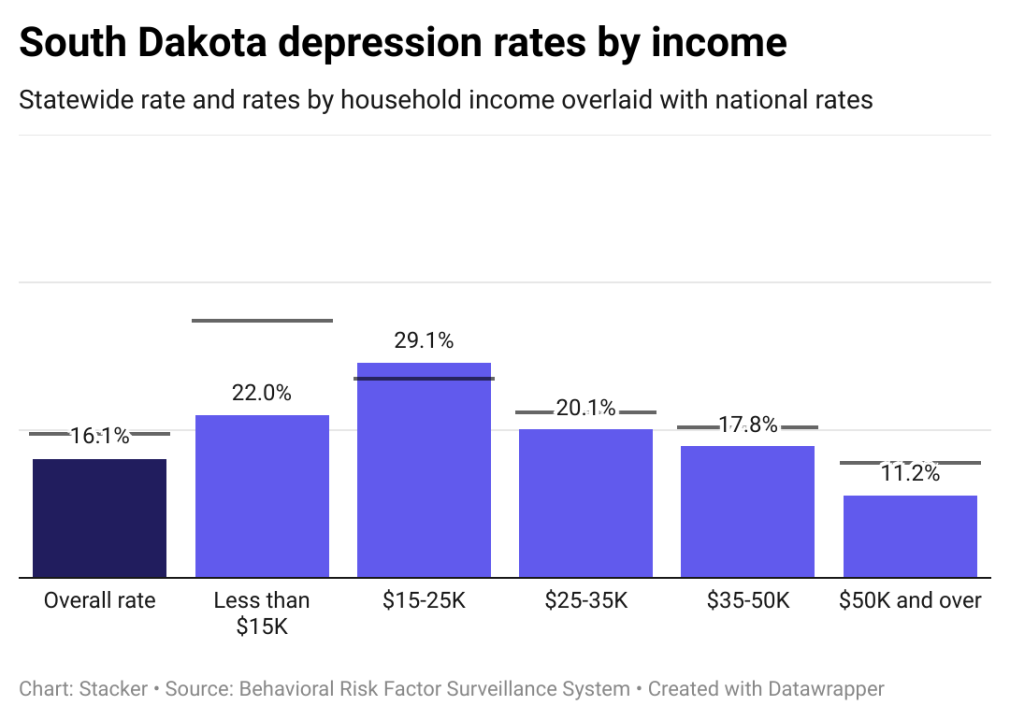
Stacker
#43. South Dakota
– Population diagnosed with depression: 16.1%
– Breakdown by sex:
— 10.2% rate for male population
— 22.1% rate for female population
– Breakdown by race/ethnicity:
— 15.8% rate for white population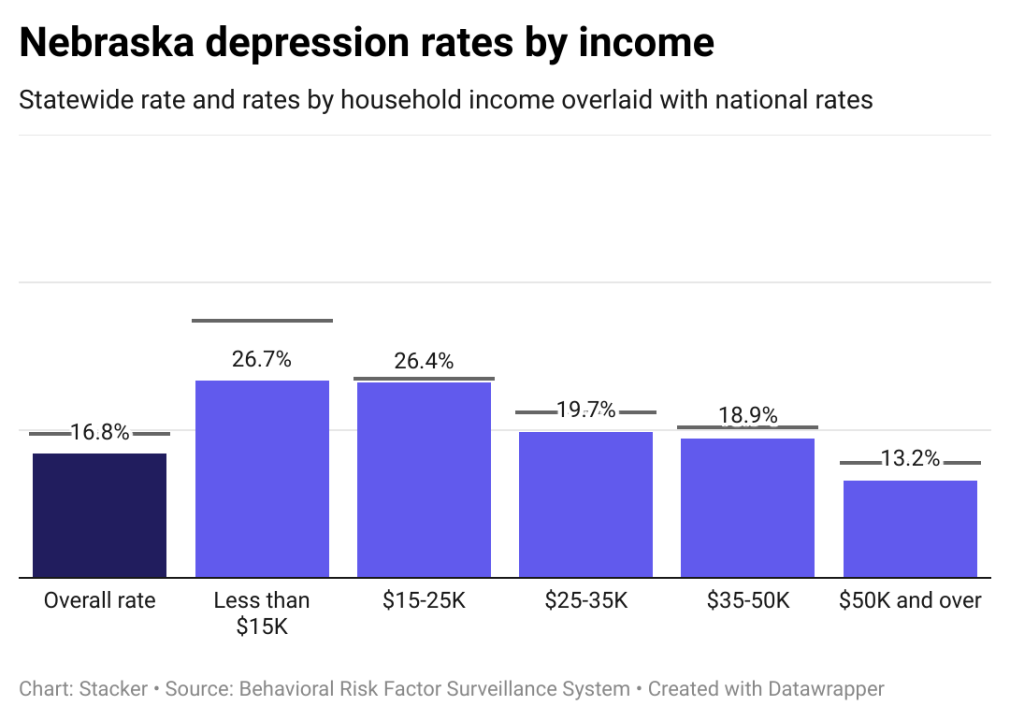
Stacker
#41. Nebraska
– Population diagnosed with depression: 16.8%
– Breakdown by sex:
— 11.4% rate for male population
— 22.1% rate for female population
– Breakdown by race/ethnicity:
— 17.6% rate for white population
— 15.4% rate for Black population
— 10.8% rate for Hispanic or Latino population
— 14.1% rate for Native American or Alaska Native population
You may also like: Over 45? Here’s how often you should be screened for these health conditions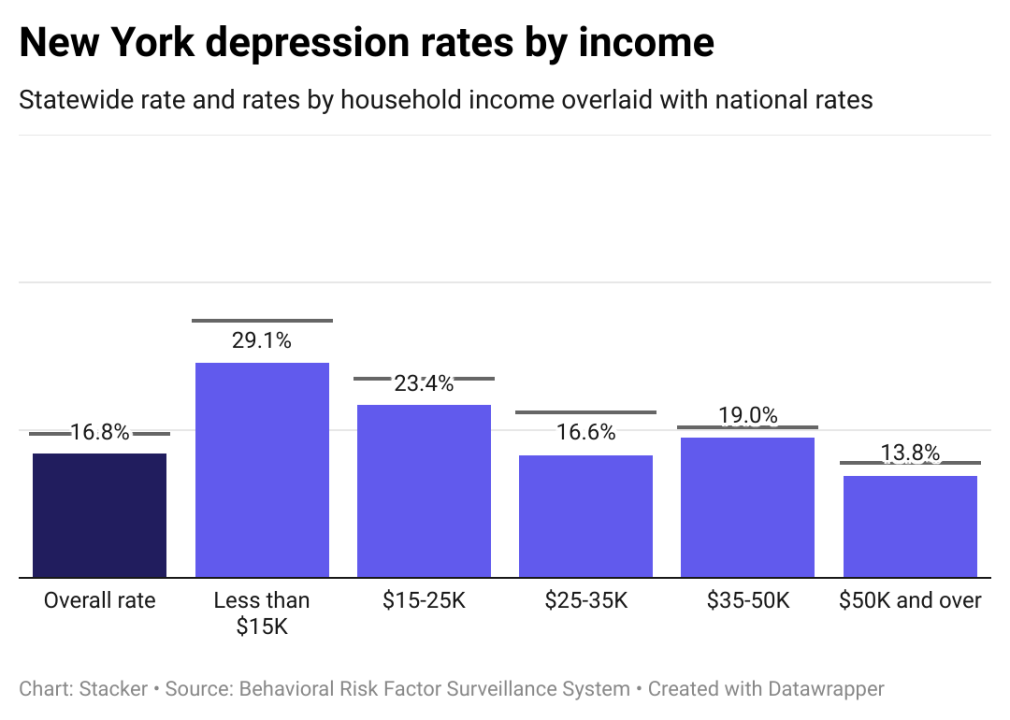
Stacker
#41. New York
– Population diagnosed with depression: 16.8%
– Breakdown by sex:
— 13.9% rate for male population
— 19.4% rate for female population
– Breakdown by race/ethnicity:
— 18.2% rate for white population
— 15.3% rate for Black population
— 17.0% rate for Hispanic or Latino population
— 8.9% rate for Asian population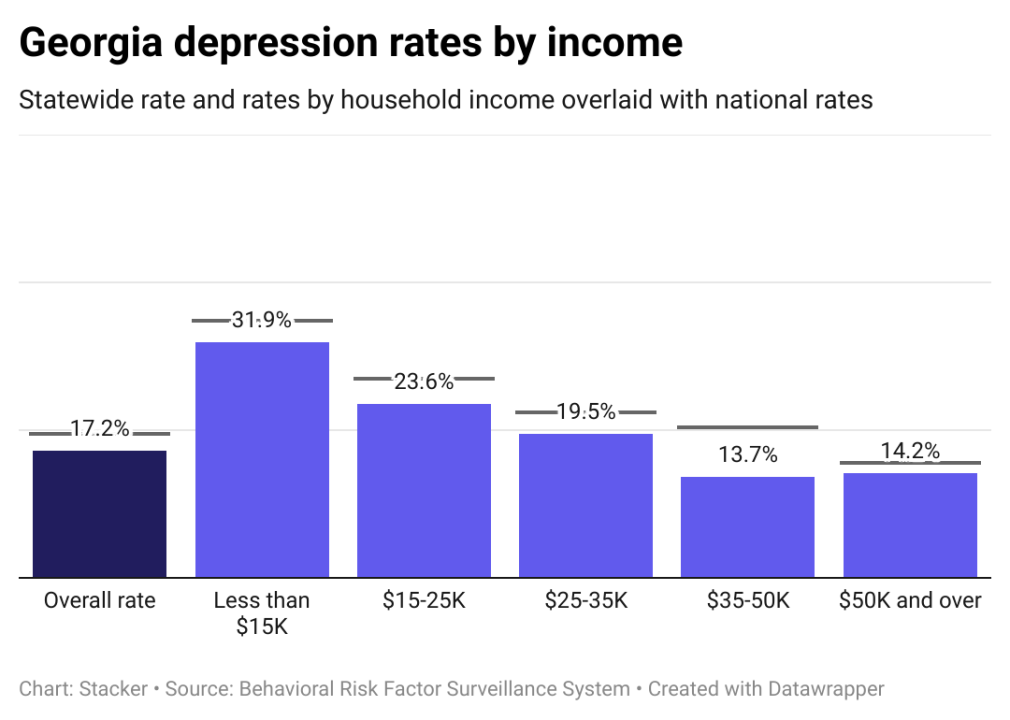
Stacker
#39. Georgia
– Population diagnosed with depression: 17.2%
– Breakdown by sex:
— 12.3% rate for male population
— 21.7% rate for female population
– Breakdown by race/ethnicity:
— 21.0% rate for white population
— 12.4% rate for Black population
— 10.9% rate for Hispanic or Latino population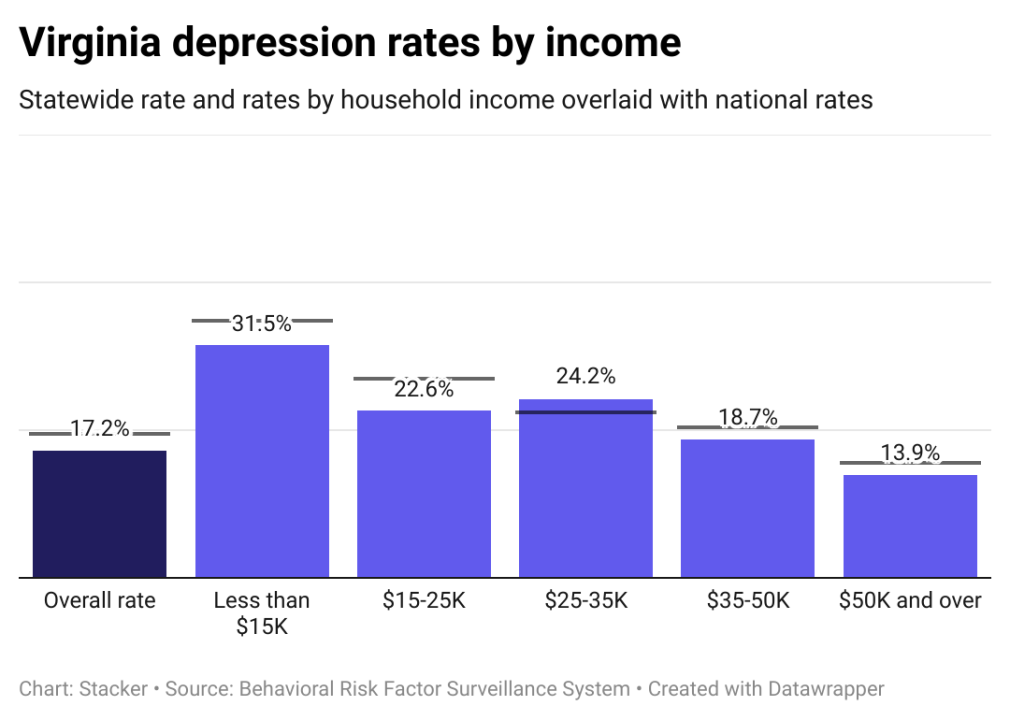
Stacker
#39. Virginia
– Population diagnosed with depression: 17.2%
– Breakdown by sex:
— 12.1% rate for male population
— 22.1% rate for female population
– Breakdown by race/ethnicity:
— 19.4% rate for white population
— 15.7% rate for Black population
— 10.1% rate for Hispanic or Latino population
— 8.6% rate for Asian population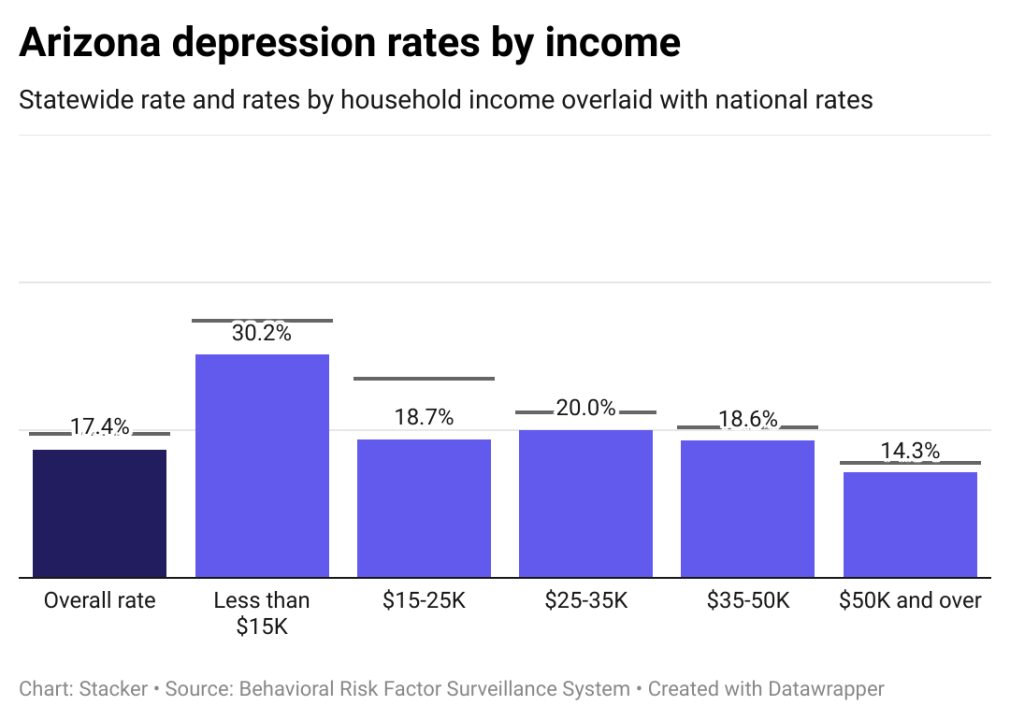
Stacker
#37. Arizona
– Population diagnosed with depression: 17.4%
– Breakdown by sex:
— 13.1% rate for male population
— 21.5% rate for female population
– Breakdown by race/ethnicity:
— 20.0% rate for white population
— 13.7% rate for Black population
— 13.8% rate for Hispanic or Latino population
— 16.2% rate for Native American or Alaska Native population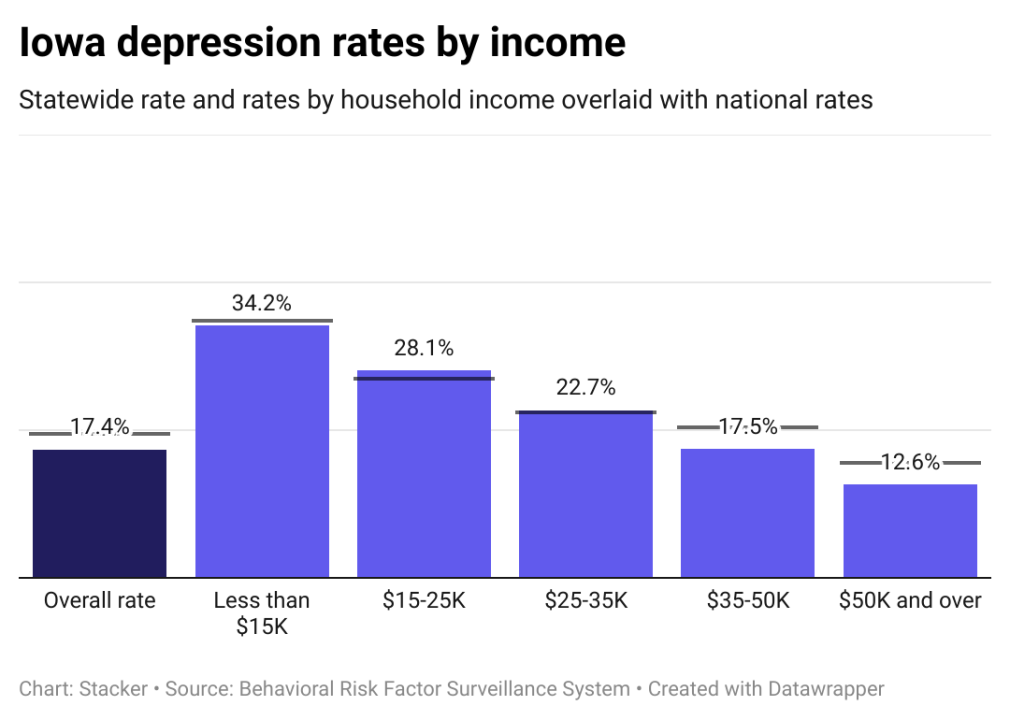
Stacker
#37. Iowa
– Population diagnosed with depression: 17.4%
– Breakdown by sex:
— 11.2% rate for male population
— 23.4% rate for female population
– Breakdown by race/ethnicity:
— 17.5% rate for white population
— 15.1% rate for Black population
— 15.3% rate for Hispanic or Latino population
You may also like: 10 potential early signs of dementia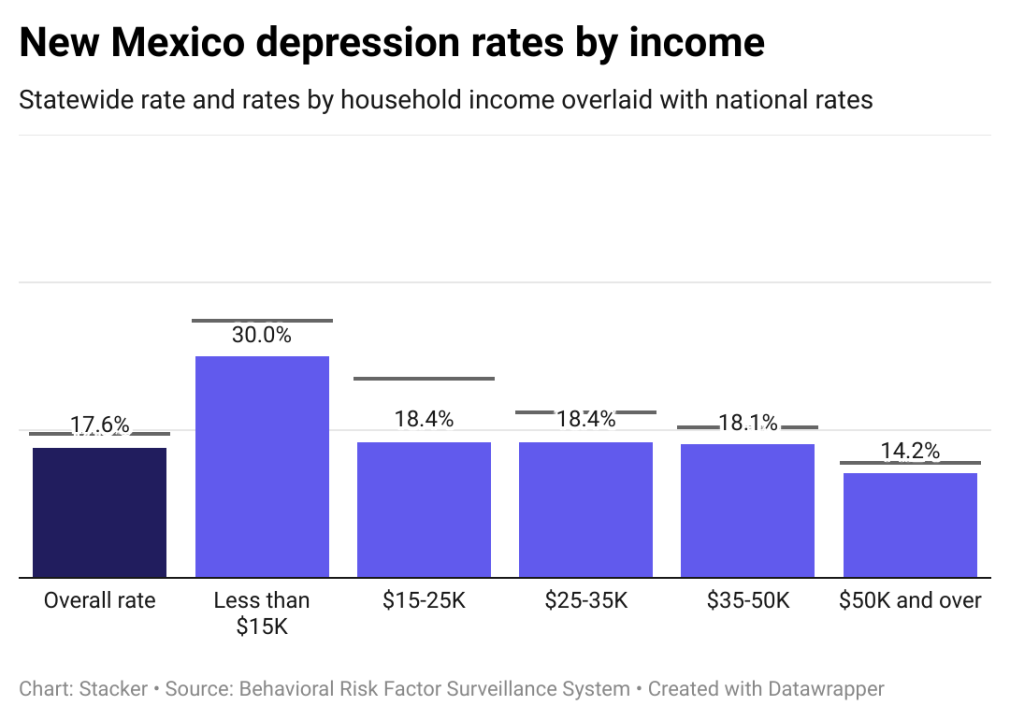
Stacker
#35. New Mexico
– Population diagnosed with depression: 17.6%
– Breakdown by sex:
— 12.5% rate for male population
— 22.5% rate for female population
– Breakdown by race/ethnicity:
— 19.8% rate for white population
— 16.1% rate for Hispanic or Latino population
— 13.3% rate for Native American or Alaska Native population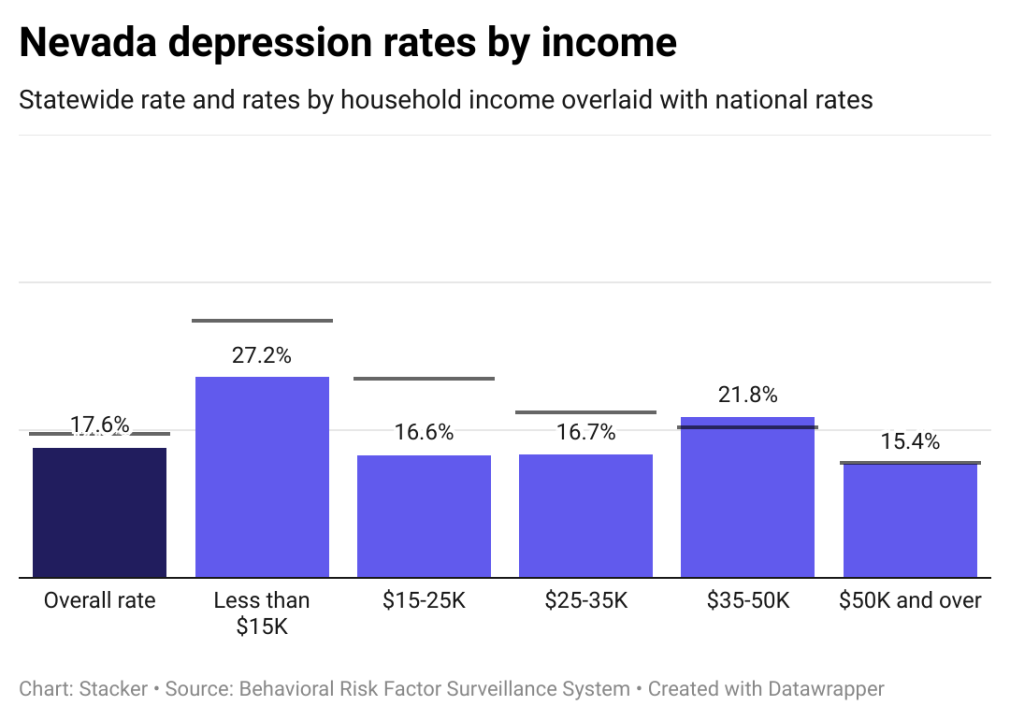
Stacker
#35. Nevada
– Population diagnosed with depression: 17.6%
– Breakdown by sex:
— 13.6% rate for male population
— 21.5% rate for female population
– Breakdown by race/ethnicity:
— 21.7% rate for white population
— 14.4% rate for Black population
— 14.2% rate for Hispanic or Latino population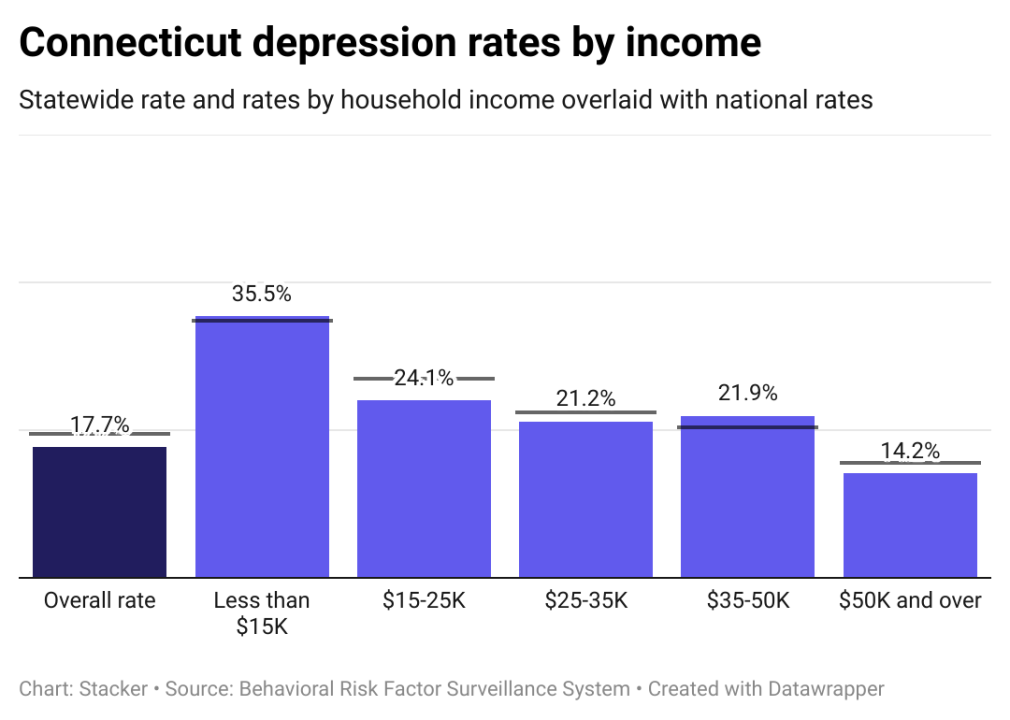
Stacker
#33. Connecticut
– Population diagnosed with depression: 17.7%
– Breakdown by sex:
— 12.2% rate for male population
— 22.8% rate for female population
– Breakdown by race/ethnicity:
— 18.8% rate for white population
— 12.2% rate for Black population
— 18.9% rate for Hispanic or Latino population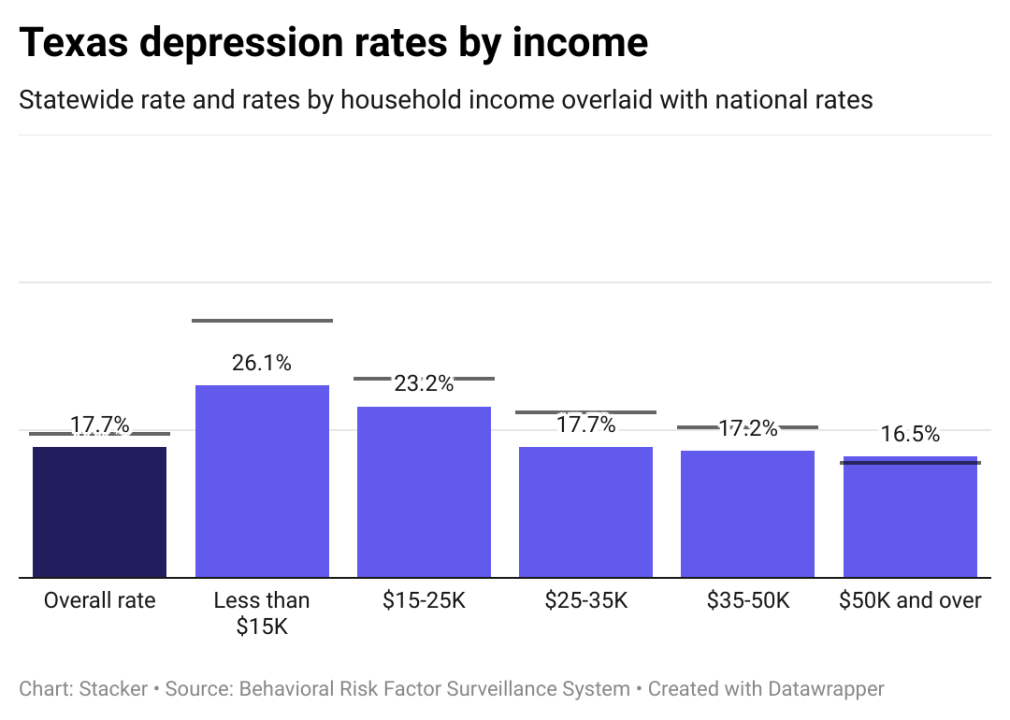
Stacker
#33. Texas
– Population diagnosed with depression: 17.7%
– Breakdown by sex:
— 12.7% rate for male population
— 22.4% rate for female population
– Breakdown by race/ethnicity:
— 21.0% rate for white population
— 16.5% rate for Black population
— 14.8% rate for Hispanic or Latino population
— 7.9% rate for Asian population
Stacker
#32. Massachusetts
– Population diagnosed with depression: 17.9%
– Breakdown by sex:
— 12.8% rate for male population
— 22.6% rate for female population
– Breakdown by race/ethnicity:
— 18.2% rate for white population
— 17.4% rate for Black population
— 23.1% rate for Hispanic or Latino population
— 6.2% rate for Asian population
You may also like: States where the most people live in maternal health care deserts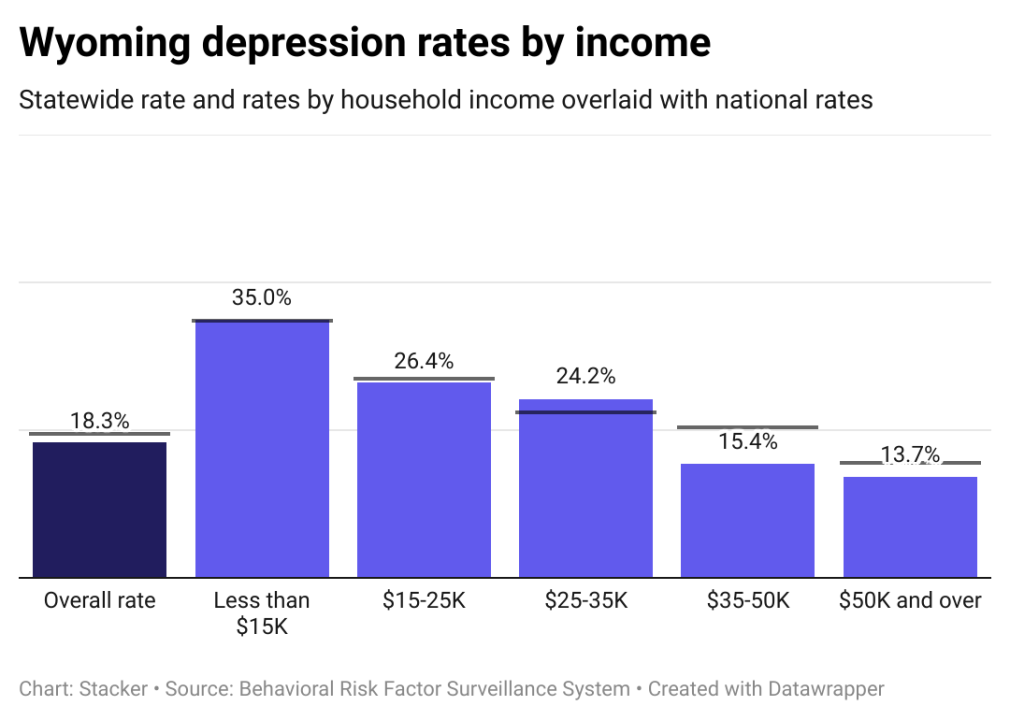
Stacker
#31. Wyoming
– Population diagnosed with depression: 18.3%
– Breakdown by sex:
— 12.1% rate for male population
— 24.7% rate for female population
– Breakdown by race/ethnicity:
— 18.3% rate for white population
— 19.9% rate for Hispanic or Latino population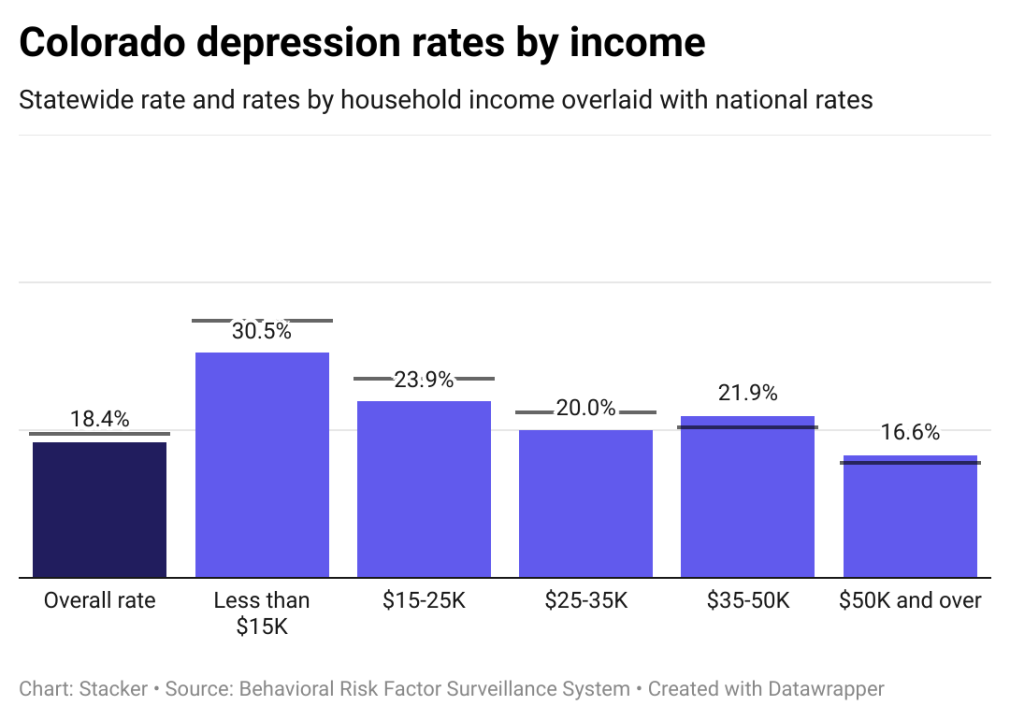
Stacker
#30. Colorado
– Population diagnosed with depression: 18.4%
– Breakdown by sex:
— 12.7% rate for male population
— 24.2% rate for female population
– Breakdown by race/ethnicity:
— 19.5% rate for white population
— 18.1% rate for Black population
— 15.3% rate for Hispanic or Latino population
— 27.6% rate for Native American or Alaska Native population
Stacker
#29. Idaho
– Population diagnosed with depression: 18.9%
– Breakdown by sex:
— 12.7% rate for male population
— 25.0% rate for female population
– Breakdown by race/ethnicity:
— 18.5% rate for white population
— 18.7% rate for Hispanic or Latino population
— 26.0% rate for Native American or Alaska Native population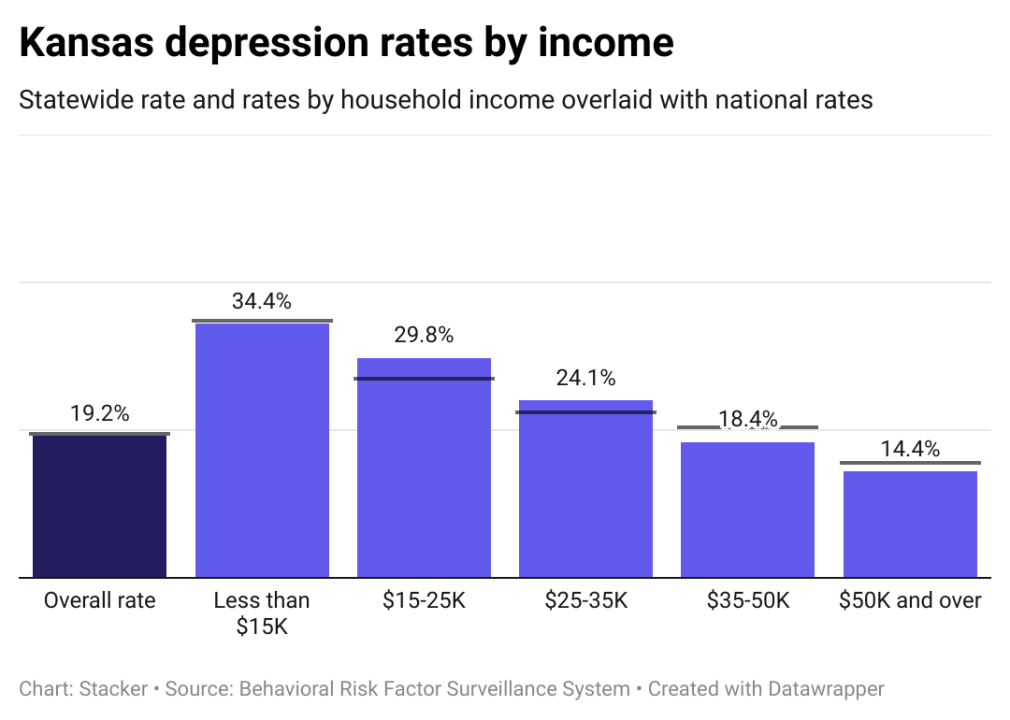
Stacker
#27. Kansas
– Population diagnosed with depression: 19.2%
– Breakdown by sex:
— 12.7% rate for male population
— 25.5% rate for female population
– Breakdown by race/ethnicity:
— 19.7% rate for white population
— 17.0% rate for Black population
— 16.2% rate for Hispanic or Latino population
— 27.2% rate for Native American or Alaska Native population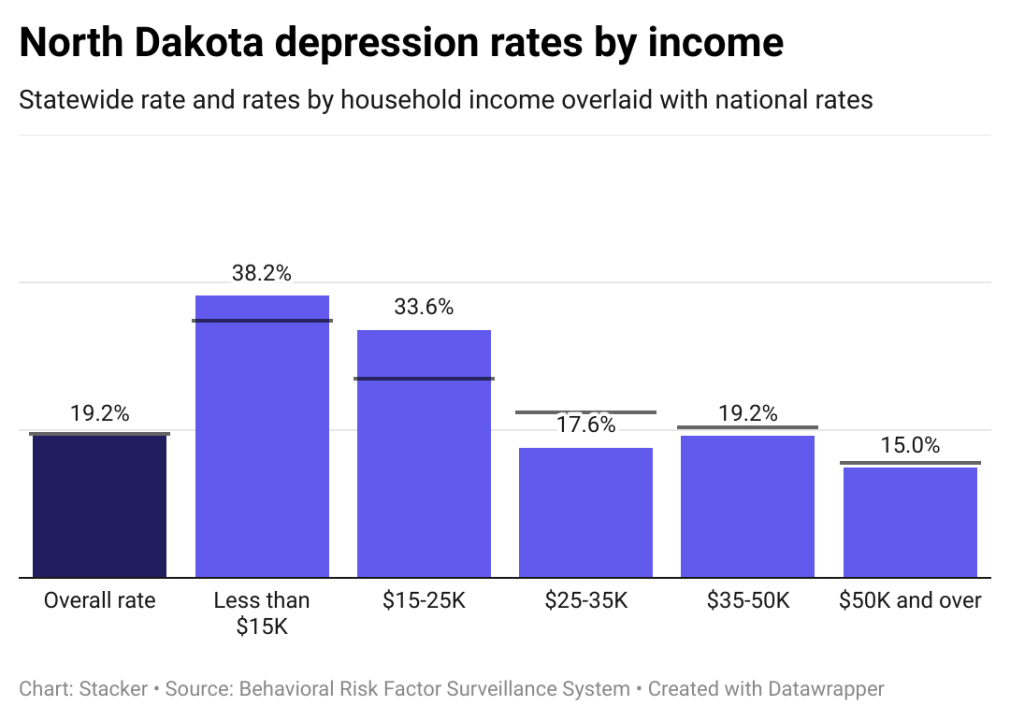
Stacker
#27. North Dakota
– Population diagnosed with depression: 19.2%
– Breakdown by sex:
— 13.4% rate for male population
— 25.3% rate for female population
– Breakdown by race/ethnicity:
— 18.9% rate for white population
— 24.7% rate for Hispanic or Latino population
— 26.1% rate for Native American or Alaska Native population
You may also like: Heart disease is the leading cause of death in the U.S.—here’s how it breaks down by state
Stacker
#26. Michigan
– Population diagnosed with depression: 19.6%
– Breakdown by sex:
— 13.8% rate for male population
— 25.0% rate for female population
– Breakdown by race/ethnicity:
— 20.0% rate for white population
— 15.9% rate for Black population
— 25.3% rate for Hispanic or Latino population
— 30.0% rate for Native American or Alaska Native population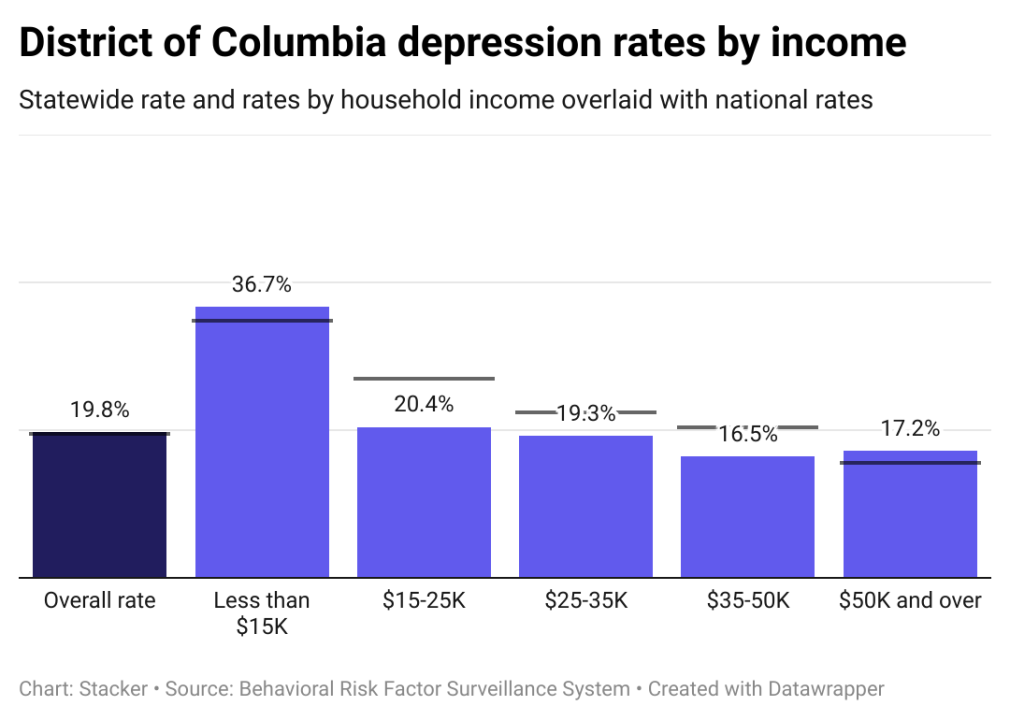
Stacker
#23. Washington DC
– Population diagnosed with depression: 19.8%
– Breakdown by sex:
— 15.2% rate for male population
— 23.9% rate for female population
– Breakdown by race/ethnicity:
— 22.5% rate for white population
— 18.3% rate for Black population
— 13.5% rate for Hispanic or Latino population
— 16.5% rate for Asian population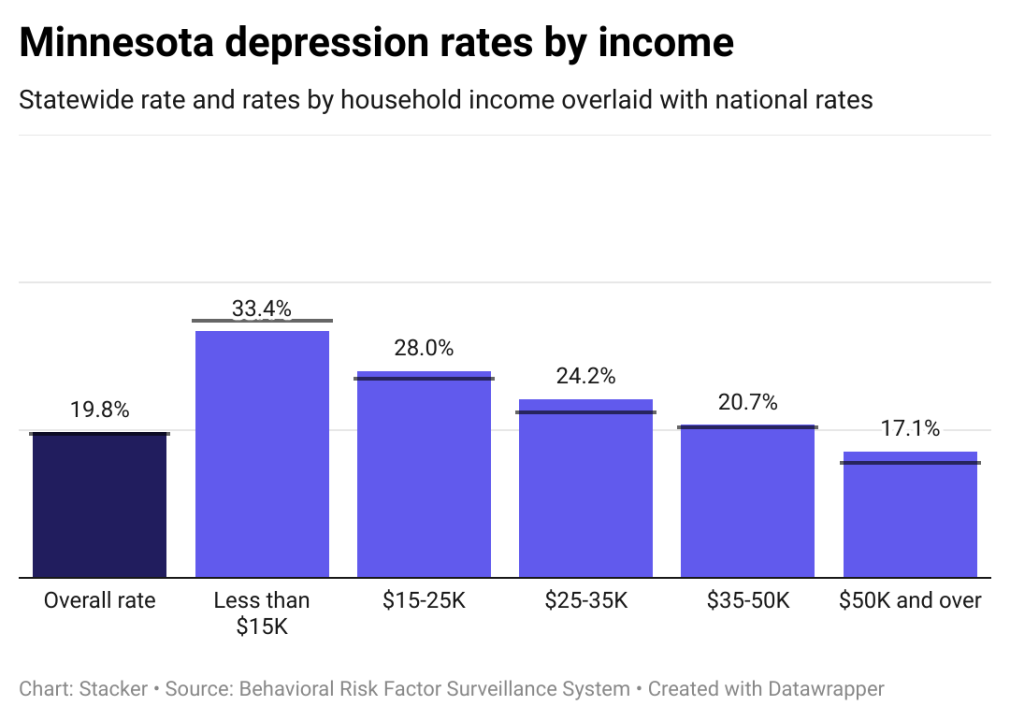
Stacker
#23. Minnesota
– Population diagnosed with depression: 19.8%
– Breakdown by sex:
— 13.4% rate for male population
— 26.0% rate for female population
– Breakdown by race/ethnicity:
— 20.7% rate for white population
— 15.5% rate for Black population
— 16.1% rate for Hispanic or Latino population
— 7.1% rate for Asian population
— 34.9% rate for Native American or Alaska Native population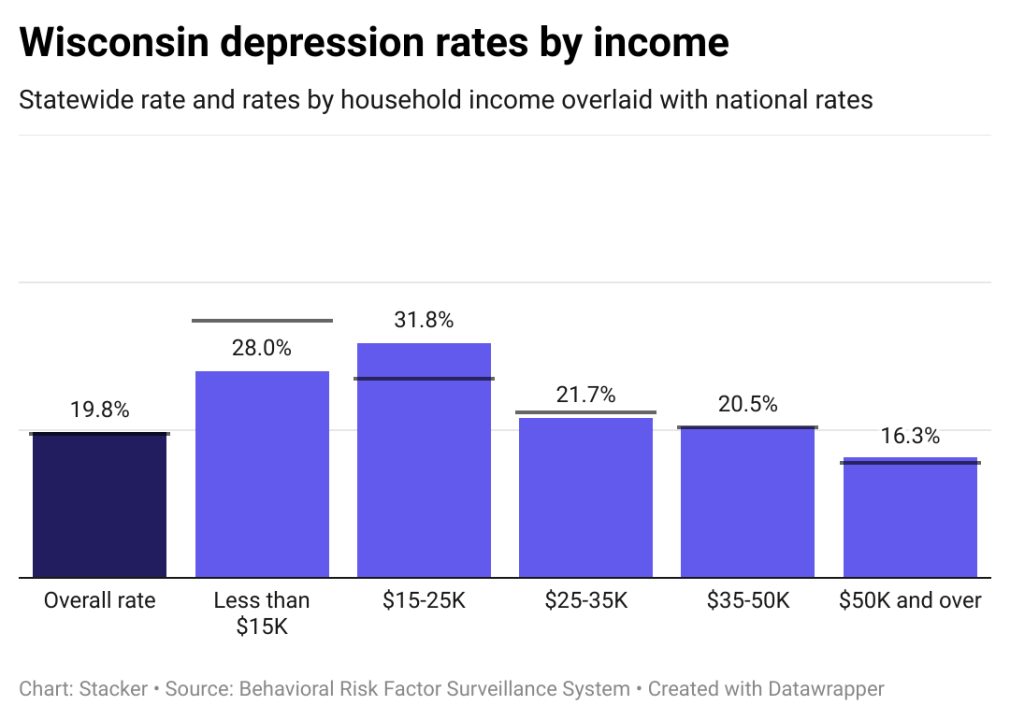
Stacker
#23. Wisconsin
– Population diagnosed with depression: 19.8%
– Breakdown by sex:
— 12.9% rate for male population
— 26.5% rate for female population
– Breakdown by race/ethnicity:
— 19.7% rate for white population
— 20.2% rate for Black population
— 19.4% rate for Hispanic or Latino population
— 39.9% rate for Native American or Alaska Native population
Stacker
#22. Pennsylvania
– Population diagnosed with depression: 20.2%
– Breakdown by sex:
— 14.0% rate for male population
— 26.2% rate for female population
– Breakdown by race/ethnicity:
— 20.0% rate for white population
— 18.8% rate for Black population
— 29.7% rate for Hispanic or Latino population
You may also like: Most common nutrient deficiencies—and the superfoods that can help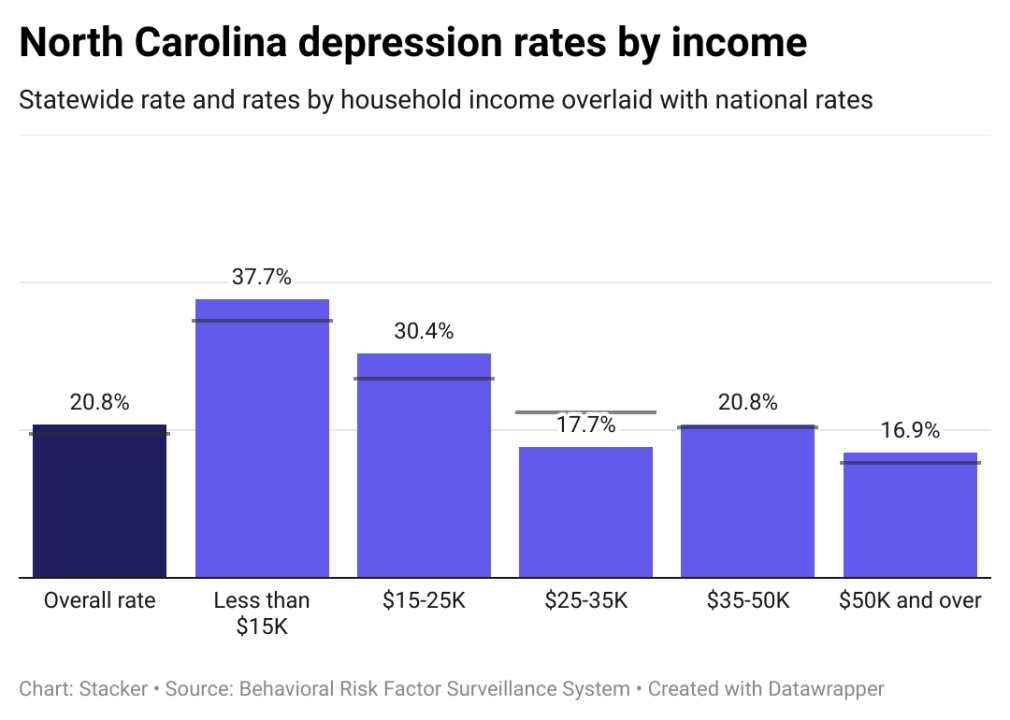
Stacker
#21. North Carolina
– Population diagnosed with depression: 20.8%
– Breakdown by sex:
— 15.2% rate for male population
— 26.1% rate for female population
– Breakdown by race/ethnicity:
— 23.4% rate for white population
— 16.7% rate for Black population
— 11.0% rate for Hispanic or Latino population
— 31.1% rate for Native American or Alaska Native population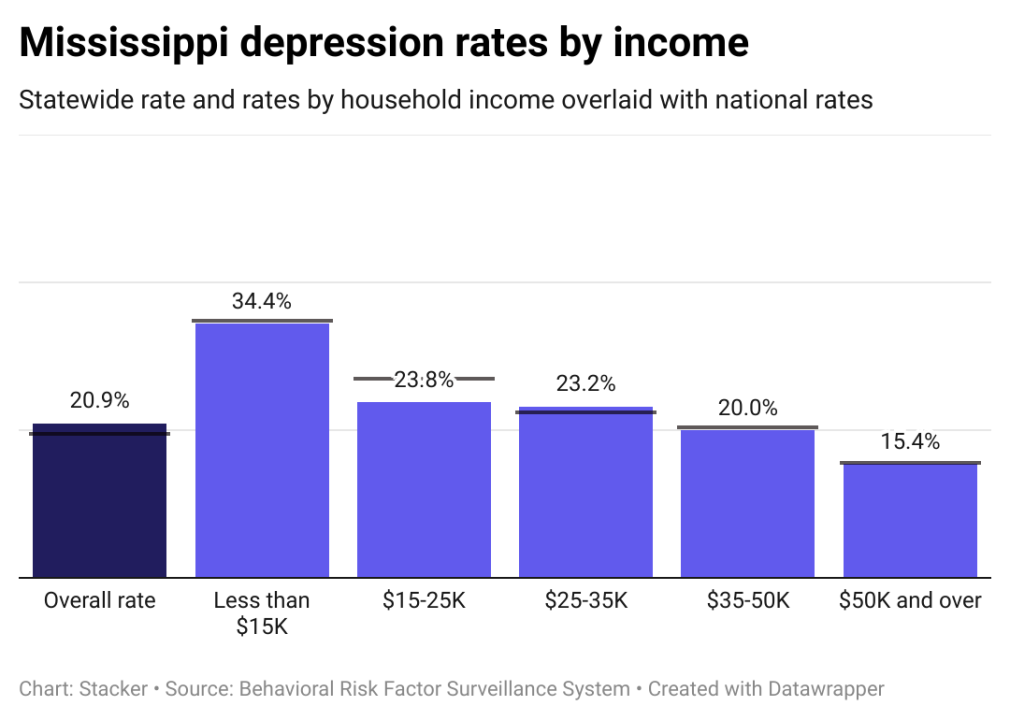
Stacker
#20. Mississippi
– Population diagnosed with depression: 20.9%
– Breakdown by sex:
— 14.8% rate for male population
— 26.4% rate for female population
– Breakdown by race/ethnicity:
— 23.4% rate for white population
— 16.1% rate for Black population
— 36.4% rate for Hispanic or Latino population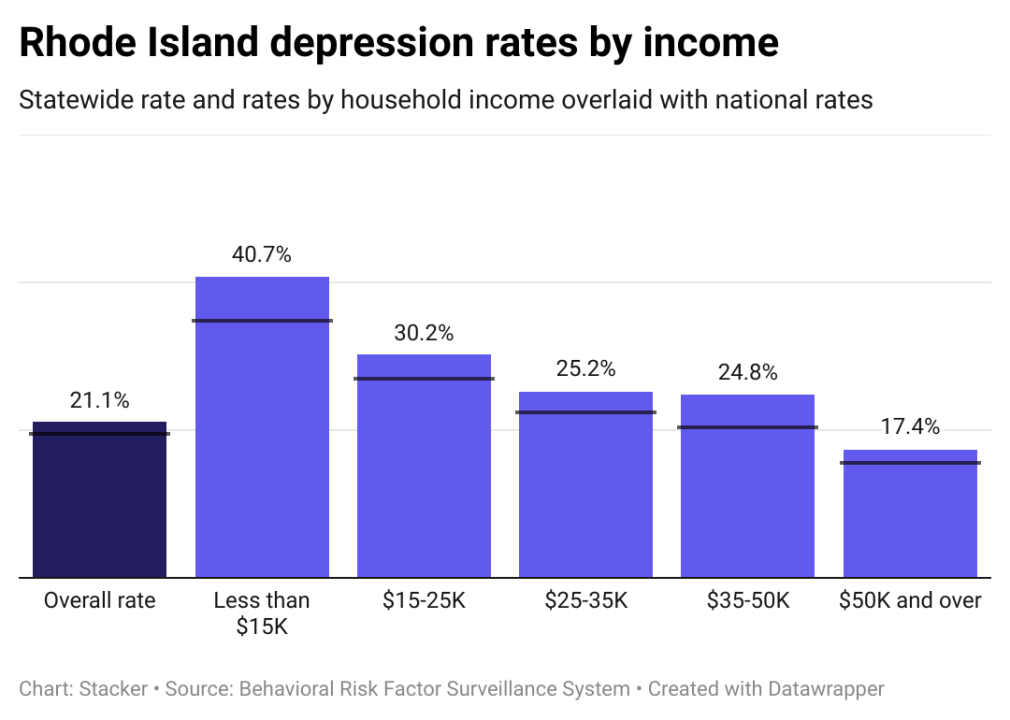
Stacker
#19. Rhode Island
– Population diagnosed with depression: 21.1%
– Breakdown by sex:
— 16.1% rate for male population
— 25.8% rate for female population
– Breakdown by race/ethnicity:
— 21.7% rate for white population
— 14.5% rate for Black population
— 20.5% rate for Hispanic or Latino population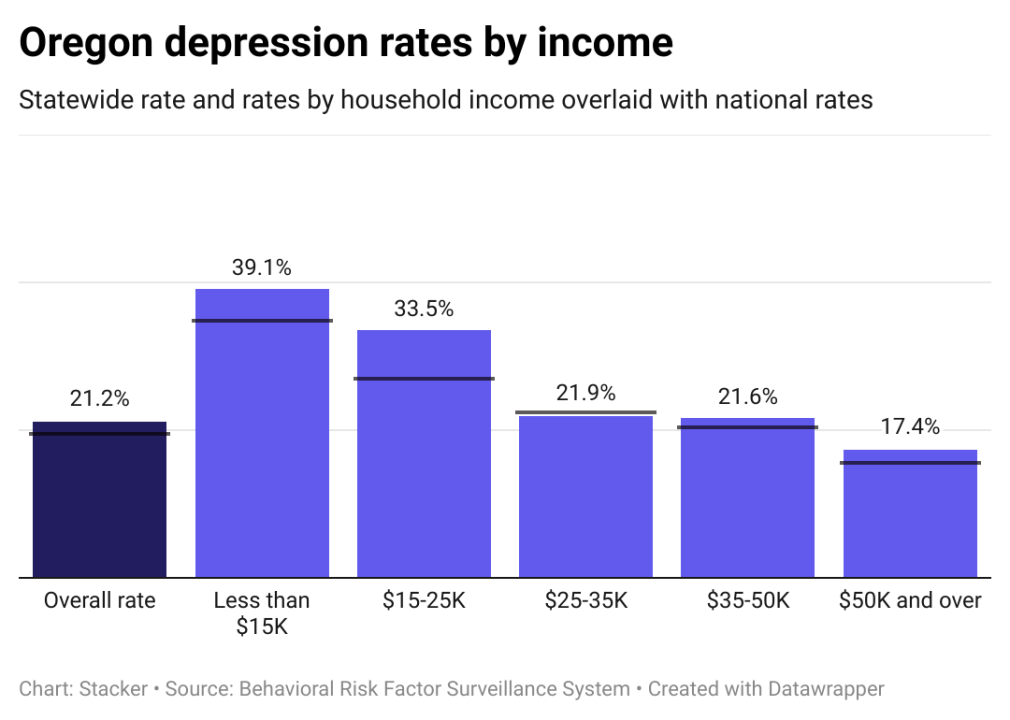
Stacker
#18. Oregon
– Population diagnosed with depression: 21.2%
– Breakdown by sex:
— 15.1% rate for male population
— 27.1% rate for female population
– Breakdown by race/ethnicity:
— 21.7% rate for white population
— 25.0% rate for Black population
— 16.6% rate for Hispanic or Latino population
— 15.9% rate for Asian population
— 17.8% rate for Native American or Alaska Native population
Stacker
#16. New Hampshire
– Population diagnosed with depression: 21.4%
– Breakdown by sex:
— 15.0% rate for male population
— 27.7% rate for female population
– Breakdown by race/ethnicity:
— 21.0% rate for white population
— 28.3% rate for Hispanic or Latino population
You may also like: 5 scientifically proven ways to improve your sleep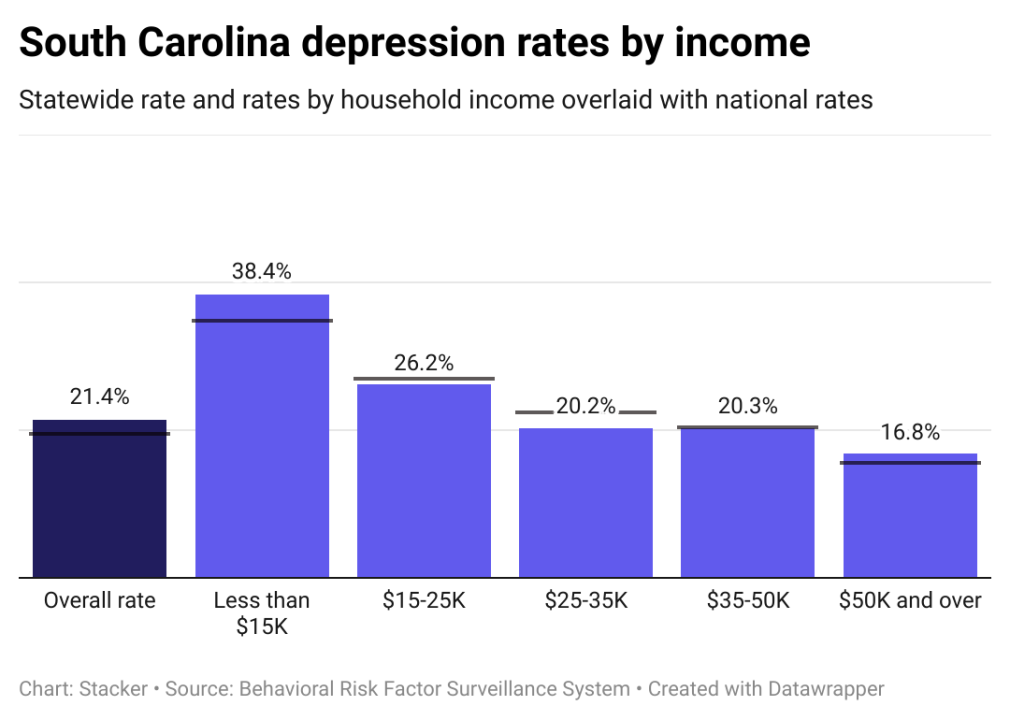
Stacker
#16. South Carolina
– Population diagnosed with depression: 21.4%
– Breakdown by sex:
— 14.5% rate for male population
— 27.7% rate for female population
– Breakdown by race/ethnicity:
— 23.1% rate for white population
— 16.2% rate for Black population
— 15.6% rate for Hispanic or Latino population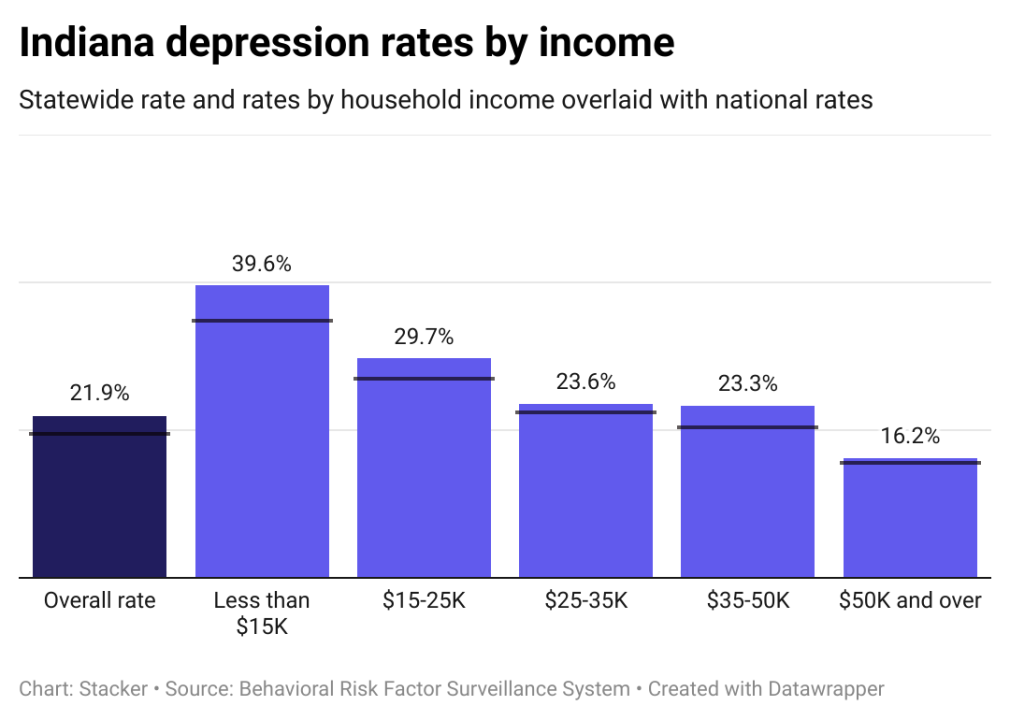
Stacker
#15. Indiana
– Population diagnosed with depression: 21.9%
– Breakdown by sex:
— 15.8% rate for male population
— 27.7% rate for female population
– Breakdown by race/ethnicity:
— 22.9% rate for white population
— 17.4% rate for Black population
— 17.8% rate for Hispanic or Latino population
— 31.2% rate for Native American or Alaska Native population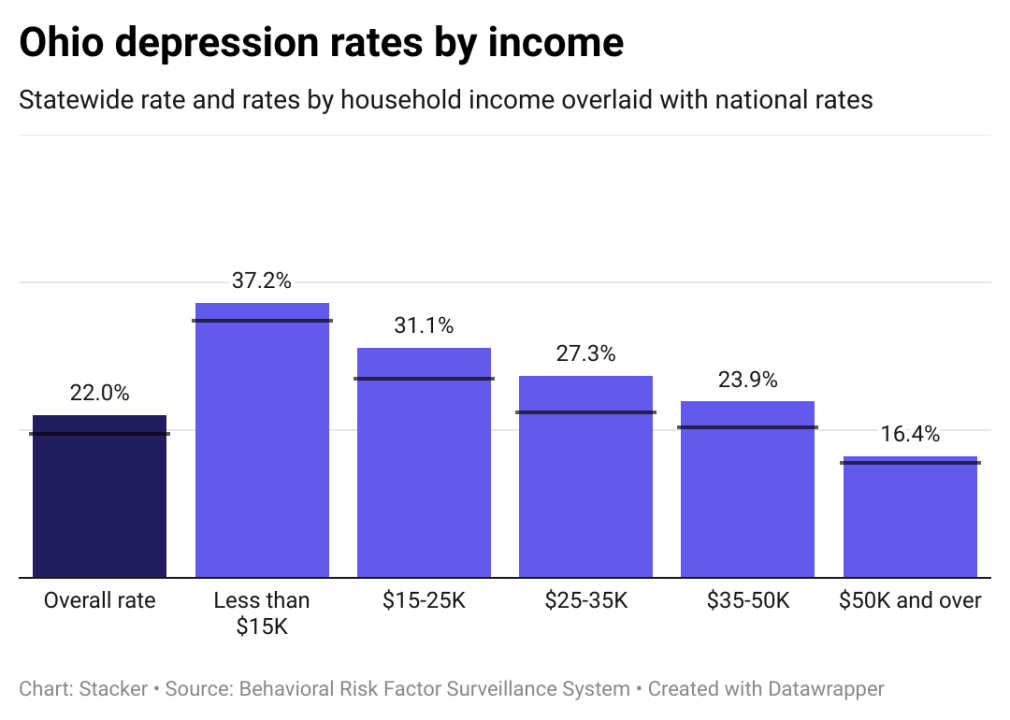
Stacker
#14. Ohio
– Population diagnosed with depression: 22.0%
– Breakdown by sex:
— 15.8% rate for male population
— 27.8% rate for female population
– Breakdown by race/ethnicity:
— 22.3% rate for white population
— 19.9% rate for Black population
— 26.0% rate for Hispanic or Latino population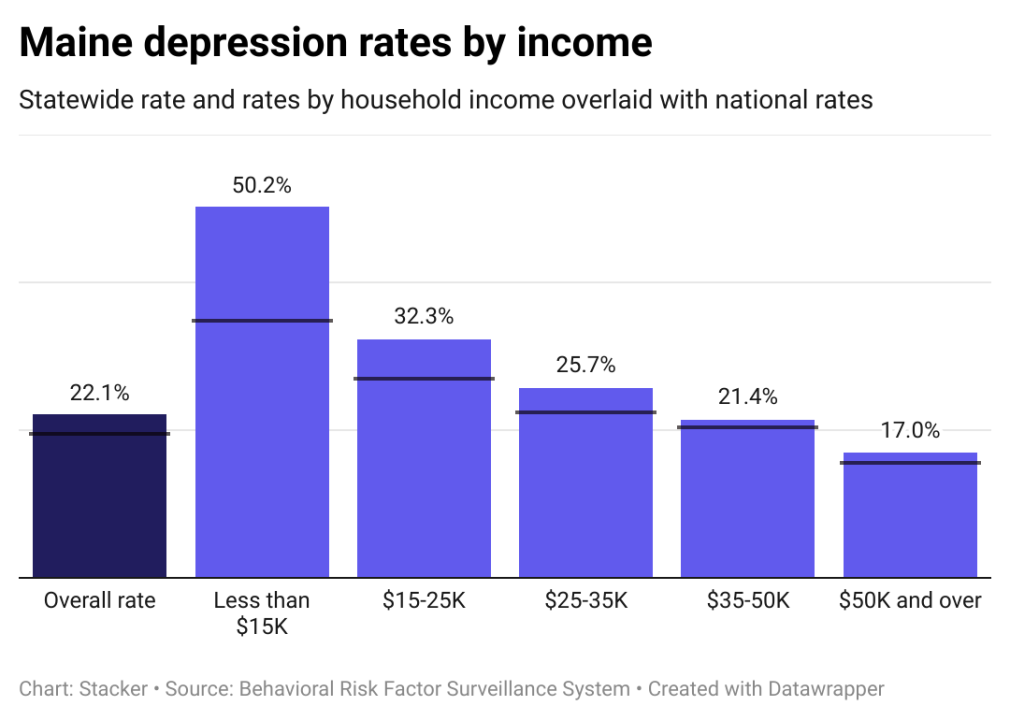
Stacker
#13. Maine
– Population diagnosed with depression: 22.1%
– Breakdown by sex:
— 16.0% rate for male population
— 27.7% rate for female population
– Breakdown by race/ethnicity:
— 22.0% rate for white population
— 26.7% rate for Hispanic or Latino population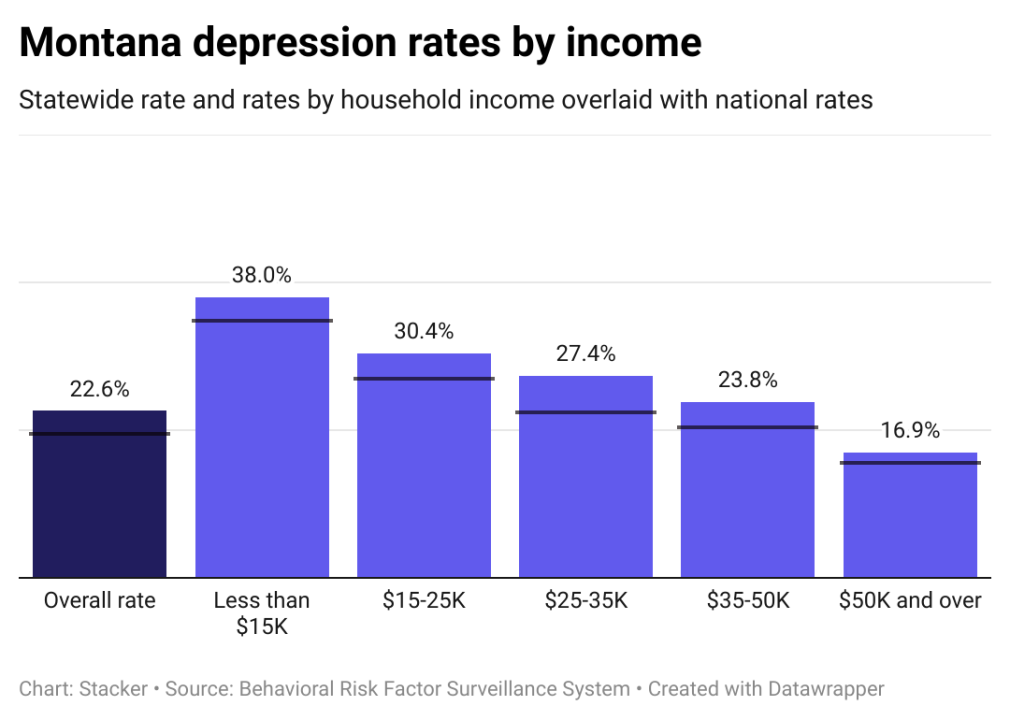
Stacker
#12. Montana
– Population diagnosed with depression: 22.6%
– Breakdown by sex:
— 15.0% rate for male population
— 30.1% rate for female population
– Breakdown by race/ethnicity:
— 21.8% rate for white population
— 28.4% rate for Hispanic or Latino population
— 29.3% rate for Native American or Alaska Native population
You may also like: 10 invasive plants that can also trigger allergies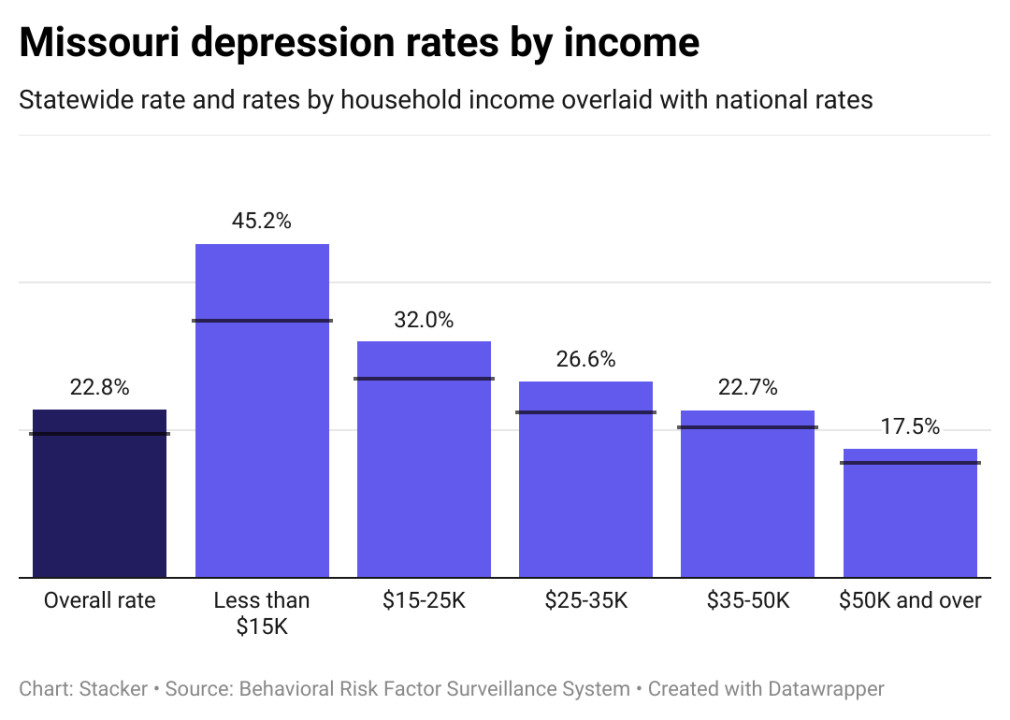
Stacker
#11. Missouri
– Population diagnosed with depression: 22.8%
– Breakdown by sex:
— 15.9% rate for male population
— 29.3% rate for female population
– Breakdown by race/ethnicity:
— 23.5% rate for white population
— 17.1% rate for Black population
— 21.4% rate for Hispanic or Latino population
— 38.4% rate for Native American or Alaska Native population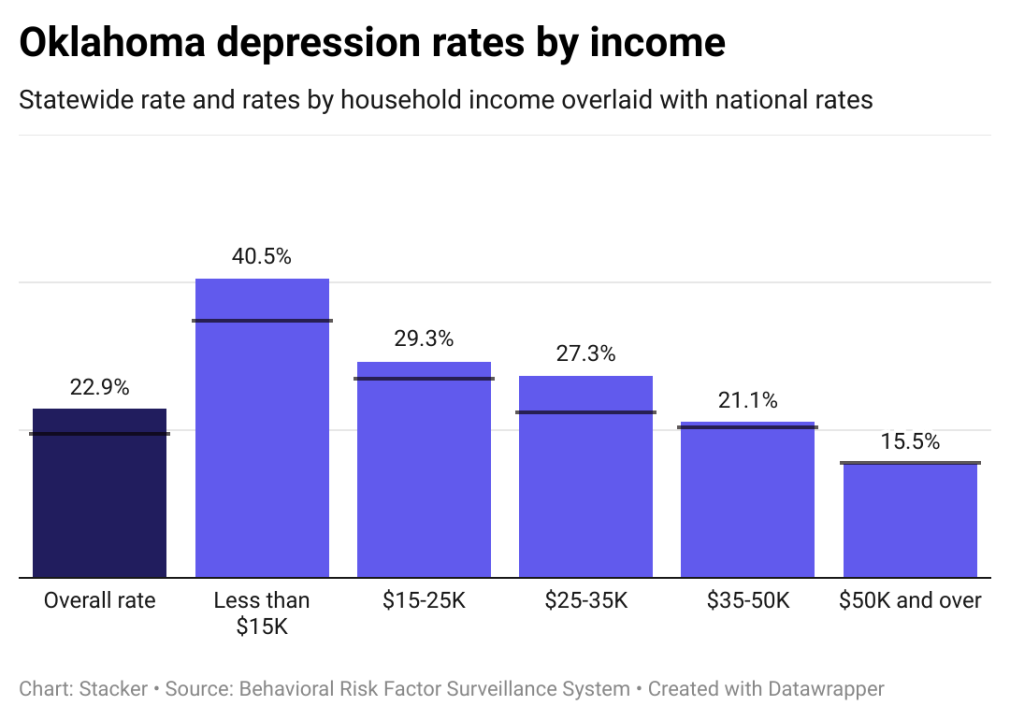
Stacker
#10. Oklahoma
– Population diagnosed with depression: 22.9%
– Breakdown by sex:
— 16.2% rate for male population
— 29.3% rate for female population
– Breakdown by race/ethnicity:
— 23.4% rate for white population
— 24.5% rate for Black population
— 15.4% rate for Hispanic or Latino population
— 25.5% rate for Native American or Alaska Native population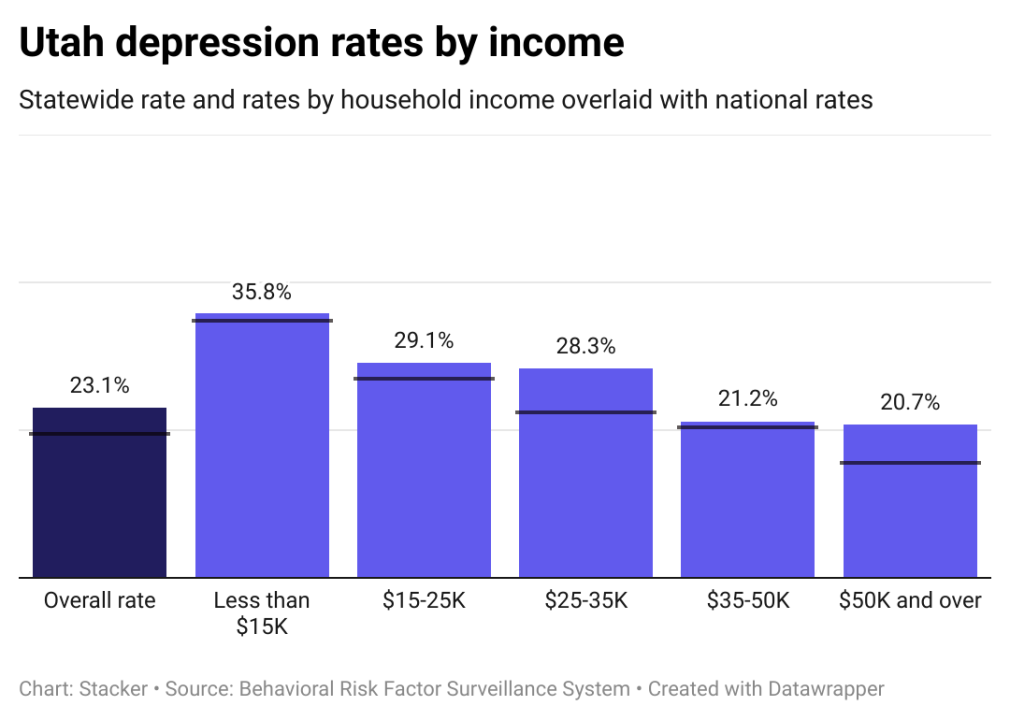
Stacker
#9. Utah
– Population diagnosed with depression: 23.1%
– Breakdown by sex:
— 16.1% rate for male population
— 30.1% rate for female population
– Breakdown by race/ethnicity:
— 24.3% rate for white population
— 20.1% rate for Black population
— 19.0% rate for Hispanic or Latino population
— 21.5% rate for Native American or Alaska Native population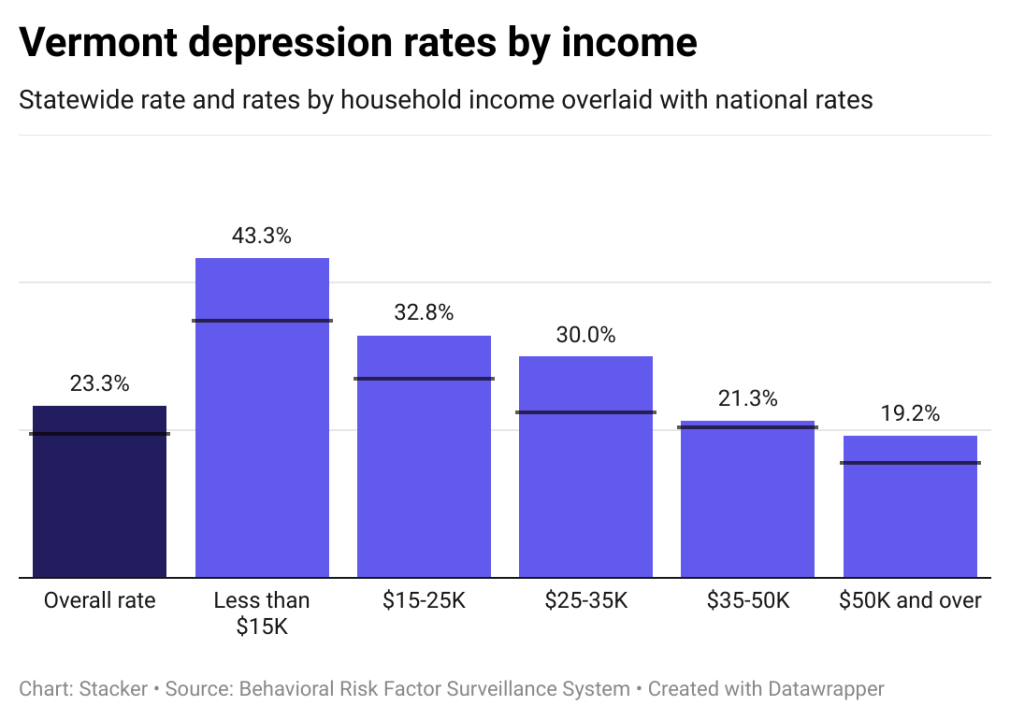
Stacker
#8. Vermont
– Population diagnosed with depression: 23.3%
– Breakdown by sex:
— 17.9% rate for male population
— 28.5% rate for female population
– Breakdown by race/ethnicity:
— 22.4% rate for white population
— 31.2% rate for Hispanic or Latino population
— 34.4% rate for Native American or Alaska Native population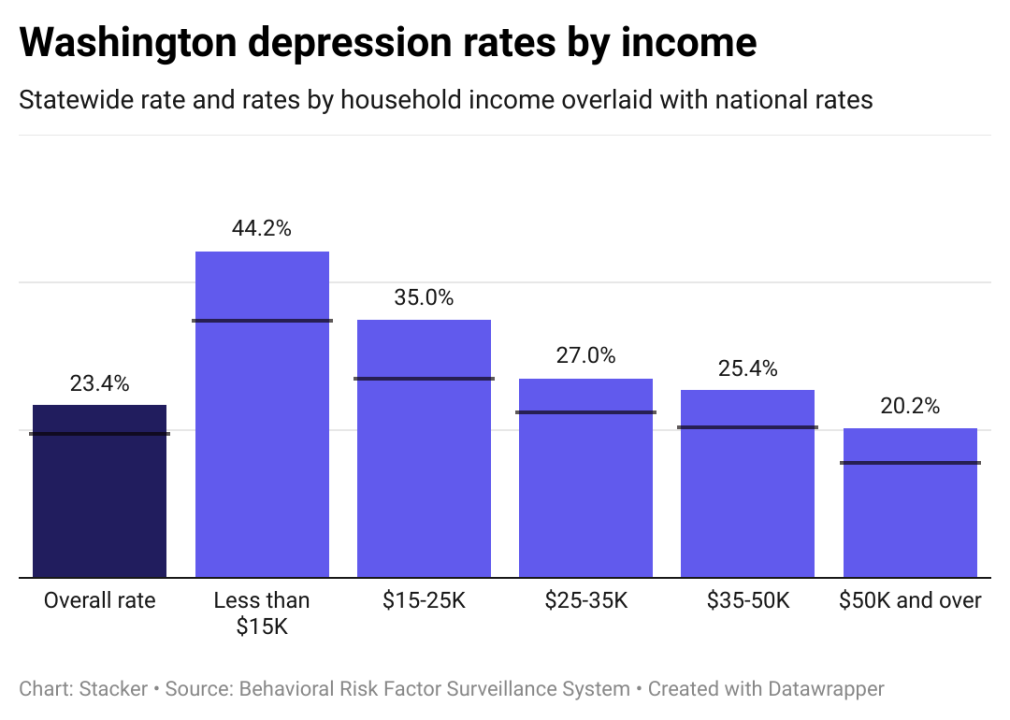
Stacker
#7. Washington
– Population diagnosed with depression: 23.4%
– Breakdown by sex:
— 17.7% rate for male population
— 29.1% rate for female population
– Breakdown by race/ethnicity:
— 25.4% rate for white population
— 22.4% rate for Black population
— 19.6% rate for Hispanic or Latino population
— 10.7% rate for Asian population
— 36.7% rate for Native American or Alaska Native population
You may also like: Most commonly misused prescription drugs in the US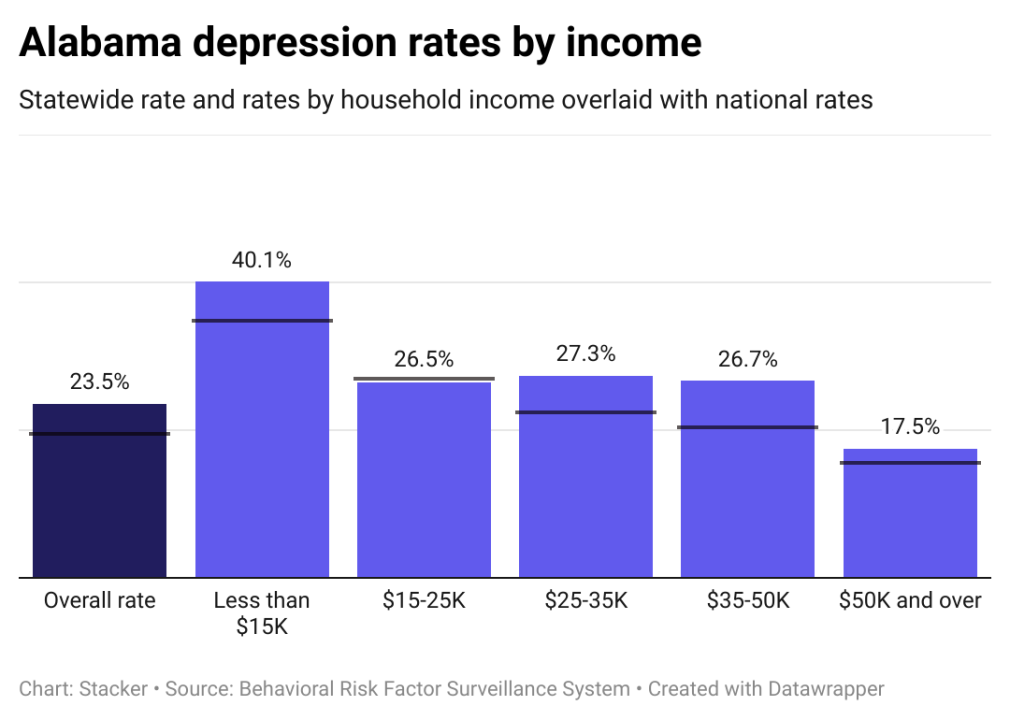
Stacker
#4. Alabama
– Population diagnosed with depression: 23.5%
– Breakdown by sex:
— 16.1% rate for male population
— 30.3% rate for female population
– Breakdown by race/ethnicity:
— 25.0% rate for white population
— 21.4% rate for Black population
— 27.5% rate for Native American or Alaska Native population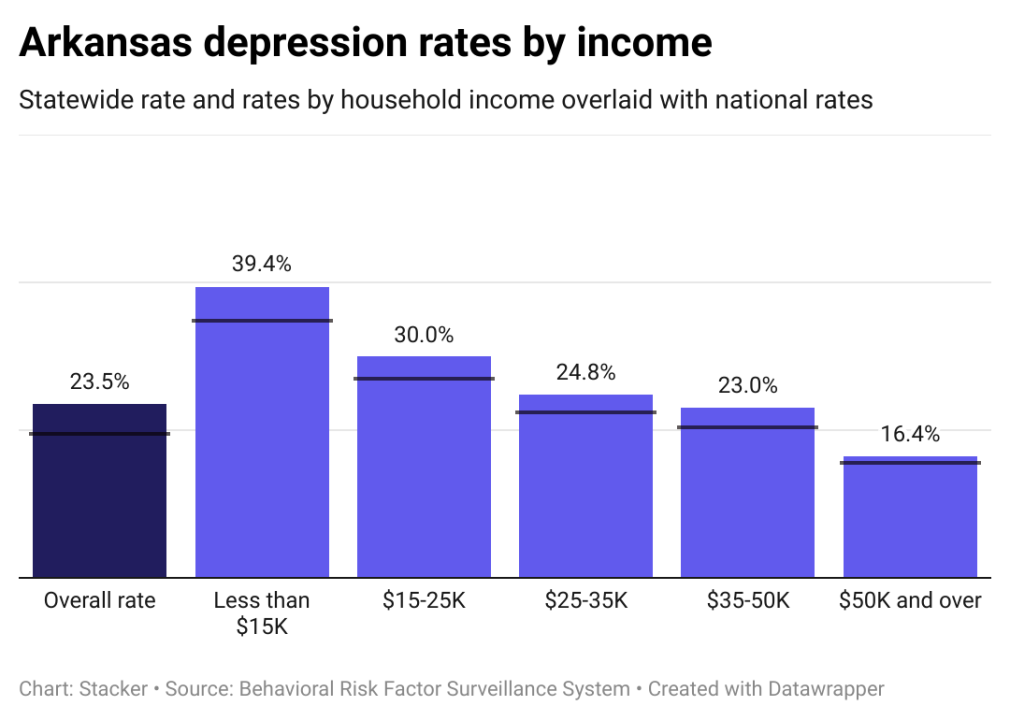
Stacker
#4. Arkansas
– Population diagnosed with depression: 23.5%
– Breakdown by sex:
— 15.1% rate for male population
— 31.4% rate for female population
– Breakdown by race/ethnicity:
— 25.1% rate for white population
— 19.6% rate for Black population
— 13.6% rate for Hispanic or Latino population
— 23.4% rate for Native American or Alaska Native population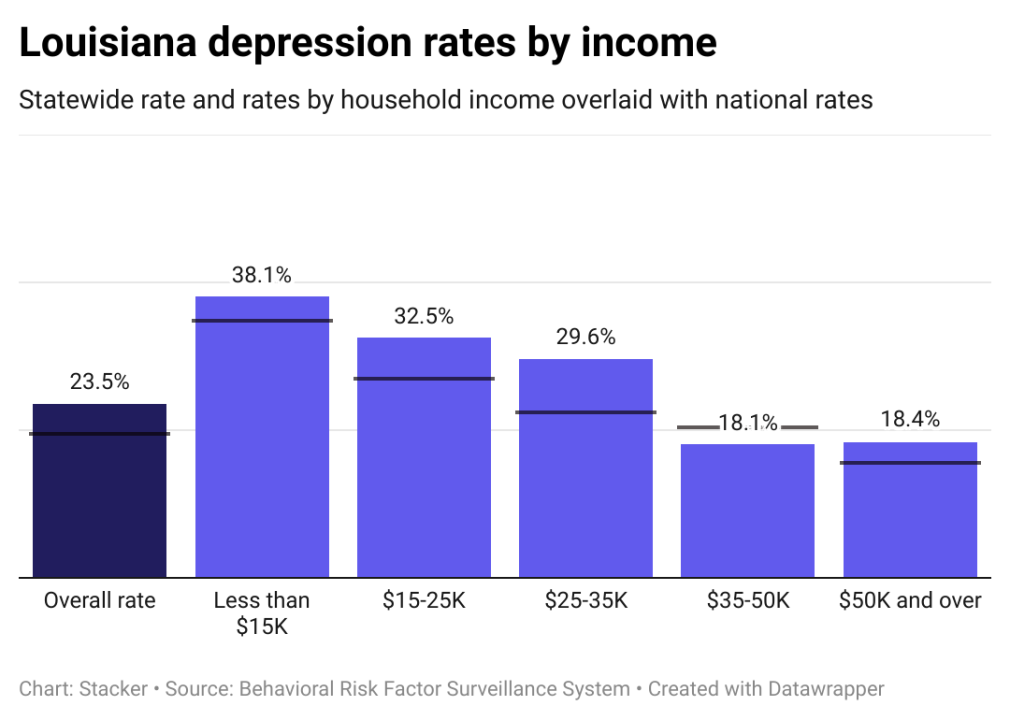
Stacker
#4. Louisiana
– Population diagnosed with depression: 23.5%
– Breakdown by sex:
— 16.6% rate for male population
— 30.0% rate for female population
– Breakdown by race/ethnicity:
— 25.0% rate for white population
— 20.0% rate for Black population
— 25.4% rate for Hispanic or Latino population
— 28.7% rate for Native American or Alaska Native population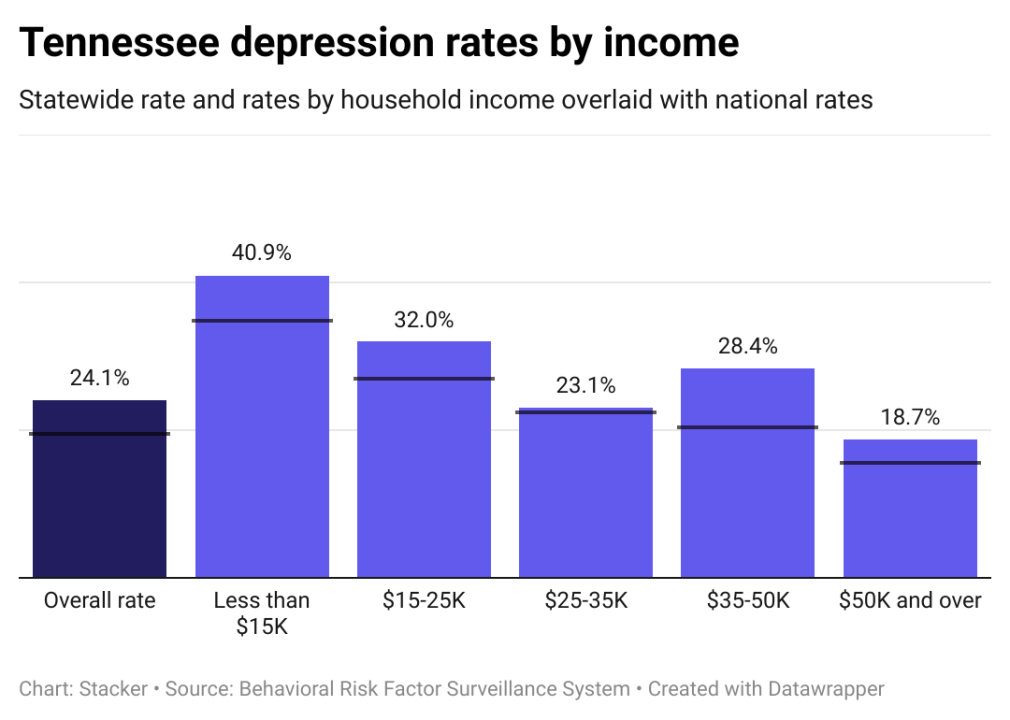
Stacker
#3. Tennessee
– Population diagnosed with depression: 24.1%
– Breakdown by sex:
— 16.5% rate for male population
— 31.2% rate for female population
– Breakdown by race/ethnicity:
— 25.1% rate for white population
— 20.9% rate for Black population
— 16.6% rate for Hispanic or Latino population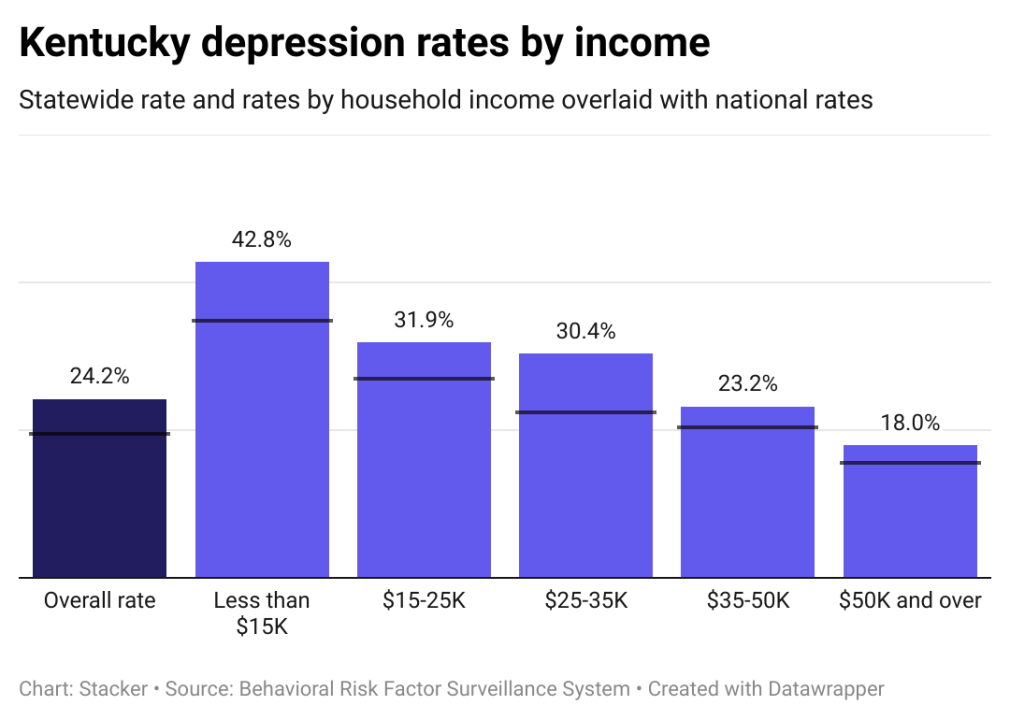
Stacker
#2. Kentucky
– Population diagnosed with depression: 24.2%
– Breakdown by sex:
— 18.4% rate for male population
— 29.7% rate for female population
– Breakdown by race/ethnicity:
— 24.8% rate for white population
— 18.8% rate for Black population
— 17.7% rate for Hispanic or Latino population
You may also like: 25 facts about food allergies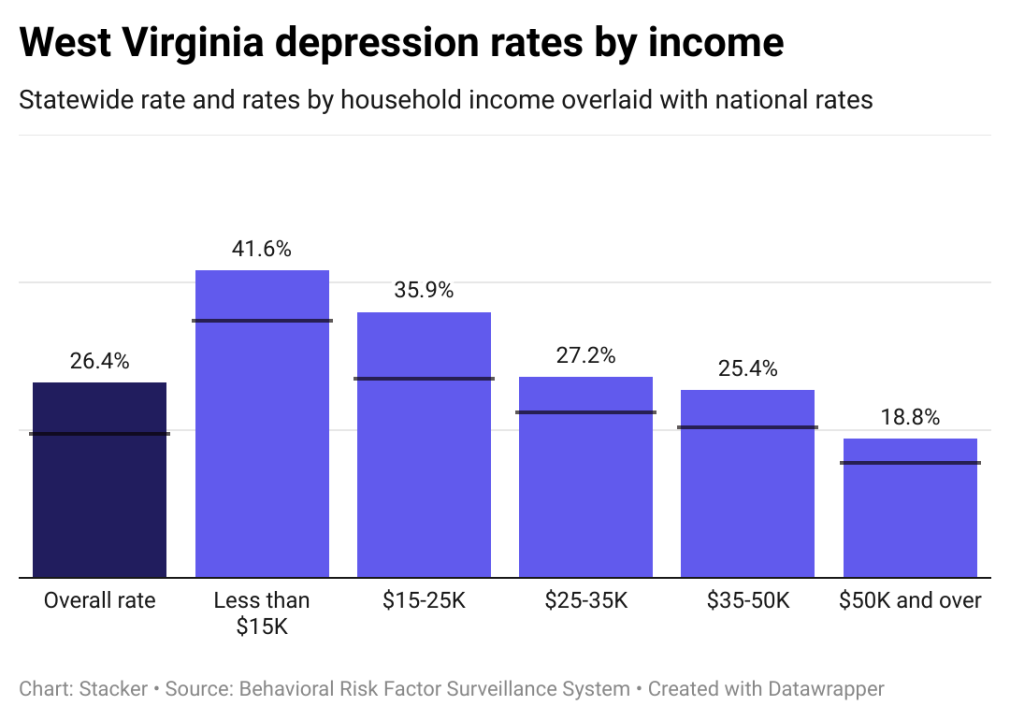
Stacker
#1. West Virginia
– Population diagnosed with depression: 26.4%
– Breakdown by sex:
— 20.1% rate for male population
— 32.4% rate for female population
– Breakdown by race/ethnicity:
— 26.6% rate for white population
— 15.2% rate for Black population
You may also like: States with the highest cancer rates

